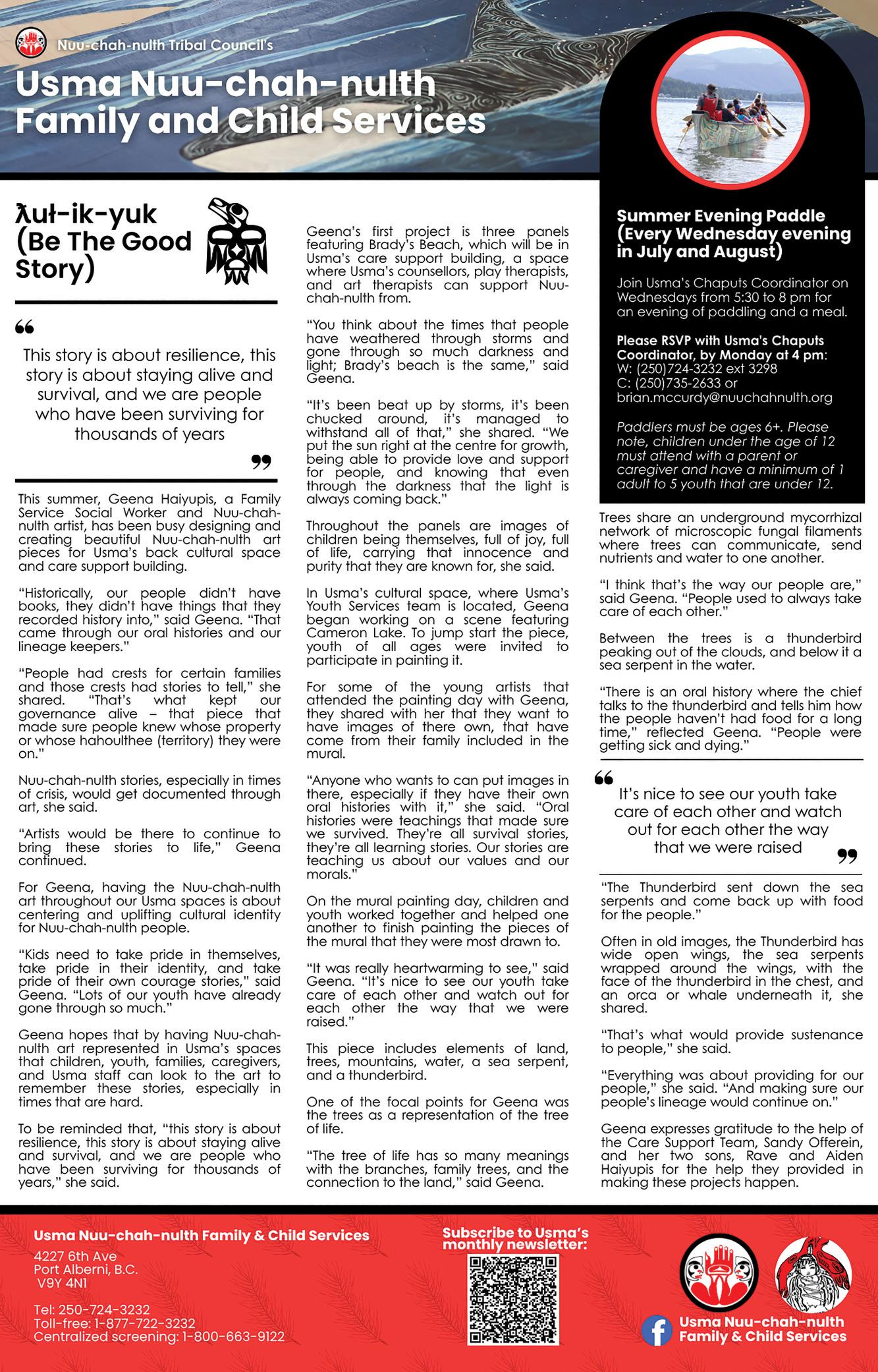

INTERESTING NEWS


On July 31 the Tseshaht First Nation celebrated the opening of its new Somass Hall, offering approximately 7,000
Somass Hall offers gathering space to fill ‘huge gap’
New facility includes floor dedicated to youth centre, cultural crafts room
By Eric Plummer Ha-Shilth-Sa Editor
PortAlberni, BC - More than a decade after the old Somass Hall was shut down for safety reasons, on July 31 the Tseshaht First Nation opened a new facility for community gathering – with a lower floor dedicated to children’s and family services.
The new Somass Hall provides approximately 7,000 square feet of space in the middle of the Tseshaht’s main reserve, a structure built with over $9 million of government funding. With sunlight pouring in from the many windows on the main floor, the facility’s large room offers a high ceiling with a modern kitchen off to one side.
The new Somass Hall was built with $3.45 million from the federal and provincial Investing in Canada Infrastructure Program, plus another $6.3 million from Indigenous Services Canada. This federal amount came according to a Canadian Human Rights Tribunal order which dictates that the federal government “fund the full cost of projects that are needed to support the delivery of [First Nation Child and Family Services] to First Nations children, youth and families on
reserve”.
As a result, the lower floor of the new hall houses a youth centre, offices and a room for cultural craft-making. It’s part of a broad range of “prevention” services, explained Tseshaht Chief Councillor Wahmeesh, Ken Watts.
“Prevention, the way we look at it as Tseshaht, are the things that help keep kids within their families,” he said. “It’s their culture, it’s their mental health, it’s their wellness, it’s education, it’s employment and training.”
During the hall’s grand opening many expressed the hope that the building will facilitate regular singing and dance practices, as was the case with the old Somass Hall that stood on the same site for over 70 years.
“It was both Tseshaht and Hupacasath,” recalled Tseshaht Councillor Les Sam of the cultural practices at the old hall. “It was one of our greatest gathering places.”
“In the mid ‘80s I joined in on the dance practices here,” Sam continued. “It was really something. I got to sing with some people who are no longer here. I learned all the songs and dances, they shared them out and taught us to carry them on.”
Sam remembers his family coming to the hall when community meals were
served.
and other children & family services
“Our whole family would take our bowls with us, we used to come here and they’d make a big pot of soup and bannock and stuff,” he remembered. “We’d all just come and share the dinner song, sit down and eat together.”
Built at the end of the Second World War with funding from Bloedel, Stewart and Welch and labour from Tseshaht members, at around 2012 it was becoming painfully apparent that the old hall had outlived its lifespan.
“It was very aged at the time,” said Sam. “We brought in some Māori dancers. They have a very aggressive dance and they collapsed part of the floor. We had about 15 or 20 of those great big Māoris there dancing in one corner and it almost collapsed the floor, which ended up being the closure of the hall for safety reasons.”
“The moment it was condemned we realized we had a huge gap in our community,” said Tseshaht Chief Councillor Wahmeesh, Ken Watts, referencing the shortcomings of other facilities in the community. “The cultural centre was too small, Maht Mahs sometimes was too big, this former hall was the perfect size.”
The new hall can house gatherings of up to 150 people, an ideal space for the
many large families within Tseshaht, said Sam.
“It’s the perfect size for big families,” he said. “It will provide more family unity in our community.”
With its own backup generator and water tank, the new Somass Hall can also serve as an emergency gathering place for those living on the Tseshaht reserve.
“We have a 30-day supply of water, we have a generator on it,” said Sam.
“The rebar that’s in the concrete here is much thicker and more sturdy than other ones because it’s supposed to withstand an earthquake,” added Watts.
Meanwhile, efforts are underway for a larger structure to replace Maht Mahs.
One of the two remaining buildings from theAlberni Indian Residential School, Maht Mahs is still frequently used for funerals and sports events, but Tseshaht members have voted to tear it down if a replacement can be built.
“We’ve got the mandate from community and support from [residential school] survivors to build a new gym,” said Watts. “We’re working on it right now to secure the funding, but we have to finalize the design.”
Eric Plummre photo
Tsunami advisory puts coastal communities on alert
Measures
enacted after one
By Eric Plummer Ha-Shilth-Sa Editor
Although the sirens didn’t go off and evacuations weren’t made, a massive earthquake that struck the north Pacific on July 29 had Vancouver Island’s coastal communities on alert.
At 4:24 P.M. Pacific time on July 29 an 8.8-magnitude earthquake struck under the ocean floor of the north Pacific Ocean, occurring 136 kilometres southeast of Petropavlovsk in Russia’s Kamchatka peninsula. This was one of the most powerful earthquakes every recorded, causing almost two million people to be evacuated from coastal areas of Japan, while four-metre waves were reported at the port of the Russian town of SeveroKurilsk.
Alerts were soon issued across the Pacific, including a tsunami advisory for the B.C. coast that came at approximately 6:30 p.m. Waves one foot above normal levels were expected to hit the west coast of Vancouver Island by 11:30 p.m., which was half an hour after low tide in Tofino.
“Stay away from coastal areas, harbours and marinas,” cautioned Emergency Info BC. “Do not go to the shore to observe the waves.”
Atsunami advisory is the second highest alert in the province, warning people to stay out of the water and away from the shore. The next level is a tsunami warning, which urges people to get to high ground immediately.
By late afternoon after the earthquake the Tla-o-qui-aht First Nation began issuing video messages for its members through social media.
“We’ve evacuated the beach,” said Chief
of the strongest earthquakes ever recorded hits north Pacific Ocean off Russia coast

Councillor Elmer Frank, who delivered the message from the First Nation’s community next to Tofino. “We’re working with Parks Canada to do the same thing over there.”
Although no evacuations were ordered, members were advised to pack four bottles of water each and any necessary medications.
“We’re asking you to pack an evacuation bag,” said Frank. “Make sure you take a blanket, make sure you take some snacks, take some drinks.”
Residents of the Hesquiaht village of Hot Springs Cove are well aware of the devastation a tsunami can bring, as a tidal wave destroyed several homes in the coastal community north of Tofino in
1964. That was the Good Friday Earthquake, a 9.2 magnitude event that struck off the coast ofAlaska on March 27, 1964.
Generations later, preparing for a tsunami has become a regular part of life for the village of a few dozen people, says Hesquiaht Chief Councillor Mariah Charleson.After the advisory was issued on July 29 the First Nation worked to ensure Hot Springs Cove residents were accounted for and warned of the possible evacuation to the Hesquiaht Place of Learning up the hill.
“There was door-to-door knocking just to see if anybody needed anything,” said Charleson.
Rick Tom Sr. was ready to shut off
power in the community if needed, while electricity at the dock was turned off.
“The dock was off limits for people,” said Charleson. “We wanted to ensure that the boats were secured and that the alarm system was working in the case that people would have to go to higher ground.”
By 6:34 a.m. on July 30 the tsunami advisory was cancelled.
The last tsunami warning on the B.C. coast came Jan. 23, 2018, after an earlymorning 7.9 magnitude earthquake struck off the coast ofAlaska’s Kodiak Island.
This prompted evacuations across the West Coast, including parts of PortAlberni, although no significant damage or injuries were reported.

Nora O’Malley photo
By the morning of July 30 things appeared calm in the Barkley Sound town of Ucluelet, although the previous evening a tsunami advisory urged people to stay away from the shore.
Wesley Ridge fire slows down, benefits from rain
The forest fire grows to 511 hectares over the August long weekend, as 204 wildfire personnel are on the scene
By Eric Plummer & Nora O’Malley Ha-Shilth-Sa Editor & Local Journalism Initiative Reporter
Cameron Lake, BC -Aforest fire that has been climbing the slope at Cameron Lake benefitted from some rain onAug. 5 and 6, a much-needed natural intervention as crews work through the night to control its spread.
Since it was first spotted on the morning of Thursday, July 31 the Wesley Ridge fire has grown to over 500 hectares.After a few days of rapid growth to the blaze on the north side of Cameron Lake, the BC Wildfire Service reported “minimal growth” overnight onAug. 4, with much of the 511 hectares affected the following day being a smouldering ground fire with no open flame.
“The northwest area of the fire is displaying the most activity, burning at Rank 2 (a low vigour surface fire with some visible flame) fire behaviour,” stated the BC Wildfire Service in an update on Aug. 5. “Heavy equipment is establishing guard on the northwest corner and along the northern edge of the fire to prevent the fire from moving to the north, working from the northeast corner to the west.”
Wesley Ridge is currently the only ‘wildfire of note’in British Columbia, and is still rated ‘out of control’by the wildfire service. Involvement has intensified as the fire has grown, with 204 personnel working to mitigate the blaze.
Resources being used include eight pieces of heavy equipment, small skimmer airplanes, land-based air tankers and seven helicopters hovering over the situation. Helicopters have been working around the clock, with night-vision being employed when it’s dark to drop water along the wildfire’s perimeter.
As the fire has spread, 387 homes and cabins have been evacuated, a widening order that now affects the shore of Cameron Lake as well as the Little Qualicum River Village and the provincial park that are on the other side of the ridge.
The wildfire service has not heard of any homes being destroyed by the fire, while no firefighters have been injured.
The popular old growth forest of Cathedral Grove has also not been affected.
“Cathedral Grove is not threatened by the Wesley Ridge wildfire,” said Madison Dahl, a fire information officer with the BC Wildfire Service’s Incident Management Team.
Cameron Lake has been closed to recreational boats, while its shores are taped
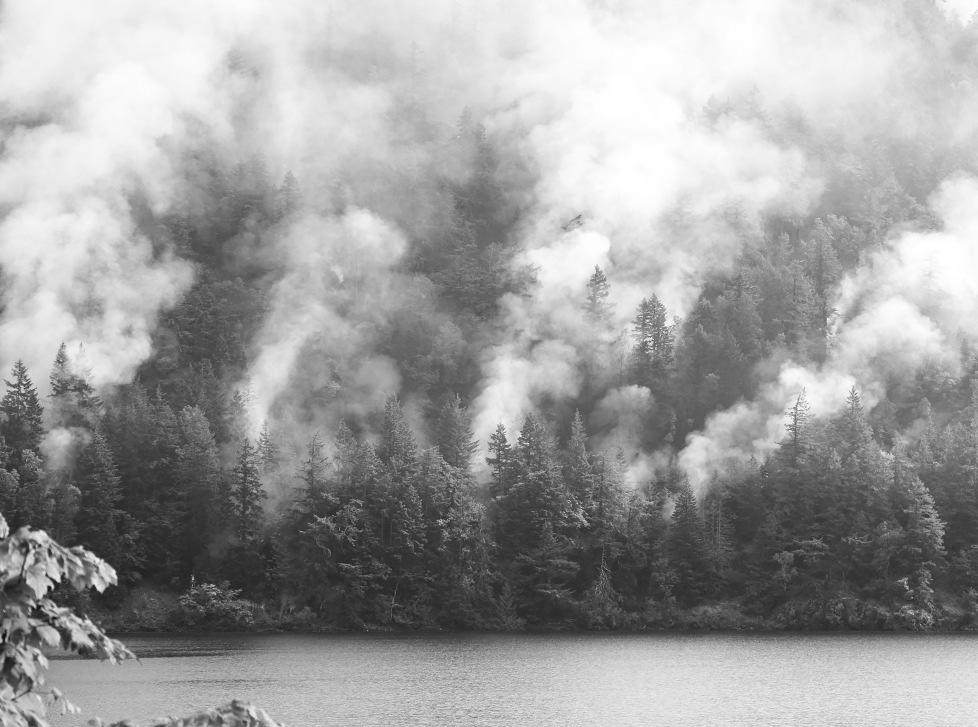
Wesley Ridge is located about four kilometres east
way 4, the main road connecting the West Coast and PortAlberni to the east
off to ensure the water can be accessed without public interference.Aircraft are also drawing upon Horne Lake, where the boat launch has been closed, and Spider Lake. Users of these lakes are encouraged to stay close to the shore if on the water.
While it was a concern among the many who relied on Highway 4 during theAugust long weekend, the major route has remained open, although motorists are being urged to not stop to watch the fire from Highway 4.
“It is very proximate to a number of the fronts of the fire, so we ask people keep moving on that route,” said Doug Holmes, emergency operations director at the Regional District of Nanaimo, which includes the area around Cameron Lake.
“Heavy equipment has built guards in workable terrain,” stated the wildfire service. “Ground crews have secured water delivery systems to improve containment and directly action the fire in order to prevent growth towards Highway 4 and maintain safe travel along the Highway 4 corridor.”
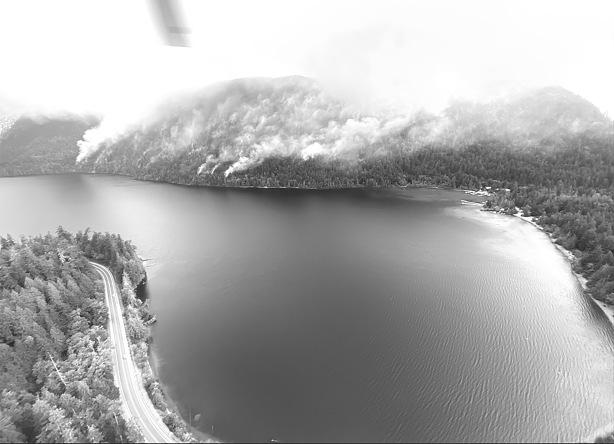

Two years ago another forest fire emerged on the other side of Cameron Lake, a cliffside blaze that sent debris onto the highway.After the Cameron Bluffs wildfire started in early June Highway 4 was completely closed for three weeks, followed by major delays until early September.As Highway 4 is the main land connector for PortAlberni and other communities on western Vancouver Island, this proved to be a major disruption through the summer of 2023.Astudy by theAlberni-Clayoquot Chambers of Commerce calculated that the economies of PortAlberni, Ucluelet and Tofino suffered $61 million in lost revenue due to the highway closure and delays, as the flow of critical supplies was disrupted and travel to Vancouver Island’s west coast became an unpredictably daunting undertaking.
The Wesley Ridge fire is believed to be human-caused – not the result of lightning, which is the most common natural origin of a wildfire. Indications from the wildfire’s early spread show the blaze
starting near the northeast shore of Cameron Lake, an area that includes an old railway trestle and trail.
The BC Wildfire Service plans to investigate the cause.
“It is currently under investigation, investigations like this take time and they are long and extensive to make sure that they are done right,” said Dahl.
Ninety-five percent of forest fires in B.C. are human caused, according to the provincial agency.
“Investigations may be carried out by one or more agencies, including the BC Wildfire Service, the Compliance and Enforcement Branch, the RCMP, or other law enforcement agencies, and may be cross jurisdictional,” noted the wildfire service.
To report smoke or fires, call 1-800663-5555 or *5555 or through the BCWS mobile app on your smart device.
For up-to-date information about driving conditions, visit: https://www. drivebc.ca/.
Irine Polyzogopoulos photo
of Cathedral Grove on the opposite side of Cameron Lake from High-
side of the Vancouver Island.
B.C. Wildfire Service photo
The Wesley Ridge fire was first discovered on the morning of July 31, near the shore of Cameron Lake.
Tofino’s parking lot for Ahousaht members draws ire
Offshore elders trek 15-minutes to the dock while the town’s paid parking program topped $568,000 in year one
By Nora O’Malley Local Journalism Initiative Reporter
Tofino, BC – Elder Qaamina Hunter used to visit Tofino two or three times a week, but those visits have spanned out, he says, due to parking woes.
Hunter lives in the offshoreAhousaht First Nations community of Maaqtusiis on Flores Island, located 30-minutes by boat from Tofino’s First Street Dock.
“It’s no fun now going through Tofino,” said Hunter. “I wish we didn’t have to get divided by mamałni (white person) choices. Some are talking about pulling membership out of Co-op and just going straight to PortAlberni or Nanaimo. We’ve had a little bit of a heartache in our life.”
Like many offshore residents from Ahousaht, Hesquiaht and the Tla-o-quiaht First Nations, Hunter says he leaves his truck anywhere in town he finds a spot, even if it risks getting a ticket.
“I’ve run out of care. If they want to take my truck, go ahead,” he said.
Tofino hosted 711,200 visitors in 2024, according to an Economic Impact of Tourism in Tofino report. While those visitors spent about $430 million in the region, between accommodations, activities, food and shopping, having so many flock to a small community means locals get hooped on nearby parking for groceries or medical appointments.
Following conversations withAhousaht leadership, the District of Tofino opened a temporary parking lot forAhousaht members in May 2025. The 30-stall parking lot is located next to the Tofino Community Hall, which is a 10-to15-minute walk or one kilometre away from Tofino’s First Street Dock.
Hunter says theAhousaht lot is “way up in the bush” and that it’s a rush for a lot of offshore members to unload their groceries and go back up the hill to park their vehicle.
“It’s gotten more difficult, especially for our elders or (people with disabilities). Our elders were always priority, but obviously not anymore,” he said.
“You gotta get a boat, you gotta walk up that hill and maybe a rest by LAGrocery and then get your breath and then walk that long, long stretch then turn left to get to that parking up there,” Hunter continued.
Ahousaht’s elected Chief Councillor naasʔałuk (John Rampanen) also lives

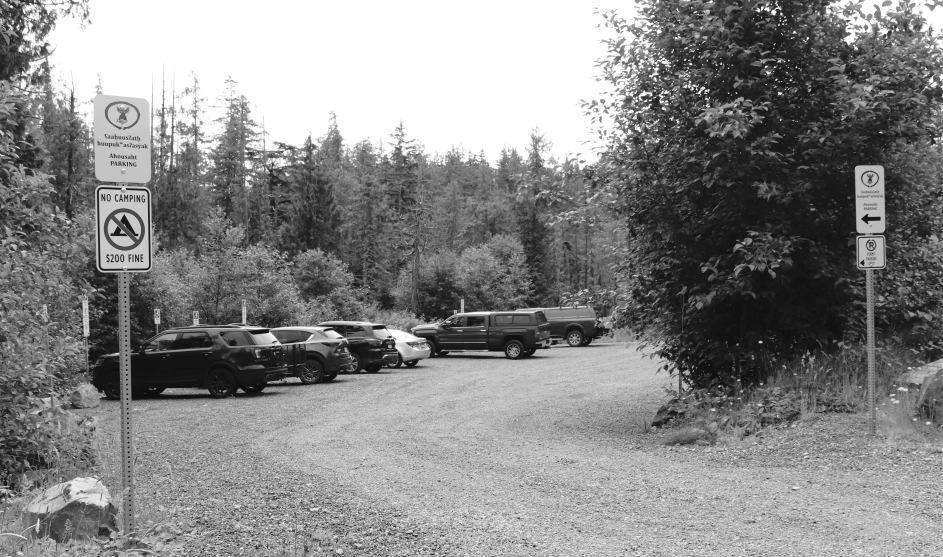
in Maaqtusiis and parks his truck up at Ahousaht’s lot by the community centre. He acknowledged that it’s a 15-minute trek from the dock.
“This is not by any means a long-term solution. We are looking at other options. Ahousaht is inquiring further into property that are for sale or for lease that are much closer to the waterfront,” said Chief naasʔałuk.
Ahousaht pays the district for the use of the lot next to the community centre. naasʔałuk told the Ha-Shilth-Sa he hopes it will be “obsolete sooner rather than later”.
They’ve had “positive conversations” with Jamie’s Whaling Station about gaining access to the waterfront portion of their property and in addition to that, they are looking at leasing the former site of Shelter Restaurant.
Ahousaht’s offshore parking needs are about 100 to 150 vehicles for residents of Maaqtusiis, according to naasʔałuk, but if the nation hosts an event, that number swiftly increases.
As of July 2025, there are about 140 designated offshore parking stalls located in Tofino’s downtown core, according to District of Tofino staff. Of those 140 offshore stalls, about 30 are assigned to Tla-o-qui-aht First Nation.
“This designation was established through ongoing discussions between the District and the Nation, reflecting a shared commitment to reconciliation and acknowledging that Tofino is within Tla-o-qui-aht’s traditional territory. These spaces are located closer to the First Street Dock to better support accessibility for Nation members,” reads a statement from district staff.
Quite often Nuu-chah-nulth-aht are mixed ancestry. naasʔałuk, for instance, isAhousaht with ties to Tla-o-qui-aht’s Seitcher family. He says the exclusive parking designation encourages “divisiveness amongst First Nations.”
Hunter thinks the designated TFN stalls should say “Tla-o-qui-aht /Ahousaht” and that theAhousaht lot up by the community centre should be for the tourists.
“They’re making it tourist first instead of local,” Hunter said.
To encourage a turnover of vehicles downtown and at the beaches and to encourage alternative modes of transportation, the District of Tofino rolled out paid

parking in 2024.
In its first full year, net revenues for Tofino’s downtown and beach pay parking programs exceeded $568,000, according to district staff. Included in the net revenues is roughly $76,000 collected from parking violations in 2024.
Revenues generated from Tofino’s pay parking flow into to the district’s Pay Parking Reserve Fund, which supports a range of community infrastructure and services. To date, district staff say the pay parking revenues have contributed to the Neill Street and Village Green revitalization, including new tennis/pickleball courts and basketball court upgrades, as well as improvements to the Wickaninnish Community School sports field.
Offshore residents can get a yearly parking permit for free, “as parking in town is their only option” - but “spaces are available on a first-come, first-served basis. Having a permit does not guarantee a space”, states the District of Tofino.
Saya Masso, Tla-o-qui-aht First Nation’s (TFN) manager of Lands and Resources, says his nation has been squeezed for footprint and land just like they are being squeezed out of parking. He wants to find that “middle space” where tourism isn’t negatively impacting locals so much.
“We will park a little further if I knew that tourism is building our basketball court or helping our language survive and building us a long house. I’ll gladly accommodate more,” said Masso, who lives in the Tla-o-qui-aht community of Opitsaht located across the inlet from Tofino.
“Parking is critical in Tofino,” he con-
tinued. “It’s incredible downtown driving around looking for a spot, but because Tla-o-qui-aht has selected some spots, it is a little easier. Still, eight out of 10 days, I’ll drive by TFN spots and they’re occupied by tourists or by other offshore nations. Come and park at 3 in the afternoon, there is not a single spot.”
Masso says Tla-o-qui-aht extended an invitation to have a luncheon with Ahousaht with the goal of working together to resolve the parking issue amongst other things.
“Hopefully we can collaborate and work together,” said Masso. He shared that he recently had a “heartfelt meeting” with Fisheries and Oceans Canada (DFO) about releasing three parking spots for Tla-o-qui-aht elders near the First Street Dock. DFO owns a building that overlooks the First Street Dock, and according to Masso, their driveway can fit six cars and they also have three down on the waterfront.
District of Tofino staff say they continue to advocate to the Province of British Columbia for increased investment and long-term solutions to address infrastructure challenges, and that they regularly meet with representatives fromAhousaht, Tla-o-qui-aht, and Hesquiaht First Nations to discuss ongoing parking needs and explore collaborative solutions.
To help support accessibility, in collaboration with TFN, the district installed a shelter at the First Street Dock in 2024 to assist families in coordinating drop-offs and pick-ups, especially for elders and individuals with mobility challenges, reads a statement from the district.
Nora O’Malley photo
The District of Tofino opened this temporary parking lot forAhousaht offshore vehicles in May 2025. It is one kilometre from the First Street Dock, making it a real trek for elders and people with disabilities.
Tofino resides within the traditional territory of the Tla-o-qui-aht First Nation. The nation has about 30 designated parking stalls close to the dock, but they are often occupied by tourists or people from other nations.
Tofino’s First Street Dock is the landing place for most offshore residents from Ahousaht, Hesquiaht and the village of Opitsaht.
New study highlights risk of accidental drownings
Alcohol and substances are a factor in 40 per cent of drowning deaths, according to a new B.C. Coroners report
By Antonella Medina Arias Ha-Shilth-Sa Contributor
PortAlberni, BC - In recognition of National Drowning Prevention Week, the B.C. Coroners Service has released its latest report on accidental drowning deaths in the province. PortAlberni makes renewed efforts to promote water safety.
In 2024 British Columbia recorded 98 accidental drowning deaths, with the four summer months from June to September accounting for 52 of them, according to the B.C. Coroners Service.
“This report, which covers a 10-year period, highlights that accidental drowning deaths continue to see an unfortunate upward trend during our warm summer months,” said Chief Coroner Dr. Jatinder Baidwan. “It is our hope that by providing regular information and details about how these deaths occur, we can help British Columbians make safer choices while enjoying water-related activities.”
Men made up 77 per cent of drowning victims, with those aged 50–59 accounting for 20 per cent of the total deaths. Individuals aged 60–69 and 70+ followed, each representing 15 per cent.According to the Lifesaving Society, some reasons that contribute to the high rate of accidental drowning in older adults include reduced physical capabilities, increased sensitivity to cold, certain medical conditions and medications that impact physical or mental capacity.
Rivers and creeks accounted for 33 per cent of drowning deaths, with accidental falls into water as the most common cause.According toAdventure Smart, a national prevention program focused on outdoor recreational activities, rivers and creeks are more unpredictable than other bodies of water due to fast underwater currents, strong undertows, and unexpected hazards like underwater debris.
Between 2014 and 2023, the report determined alcohol and/or drugs were a contributing factor in 40 per cent of accidental deaths by drowning. Substance involvement was lowest among those under 19 years of age and over 70. Individuals between the ages of nineteen and sixty-nine had the highest consumption.
However, the report clarifies that there is more than one factor in the incidents.
The coroners determine the importance of alcohol or drugs in deaths once the investigation is closed.
“Anyone can drown, even people who
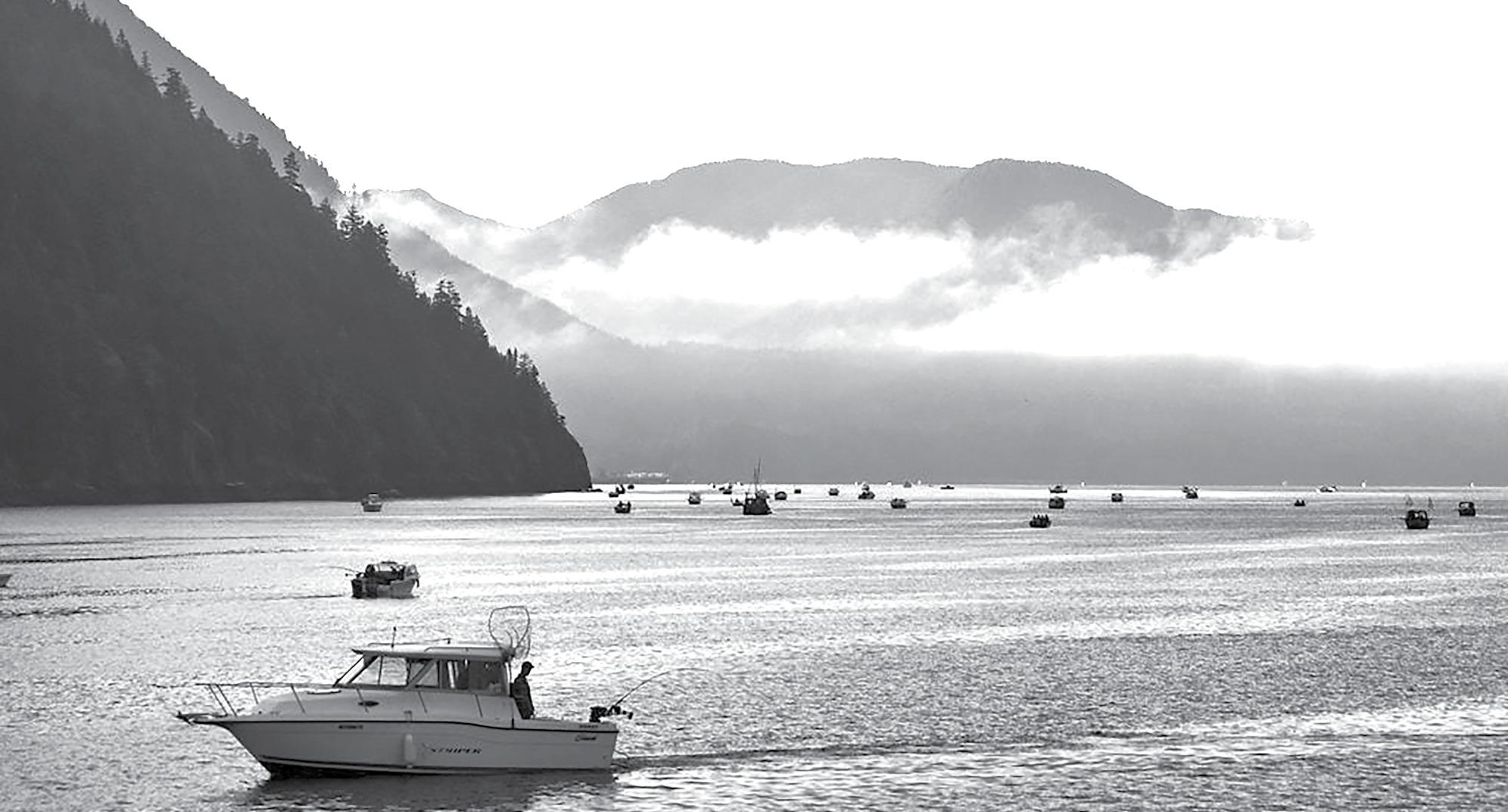
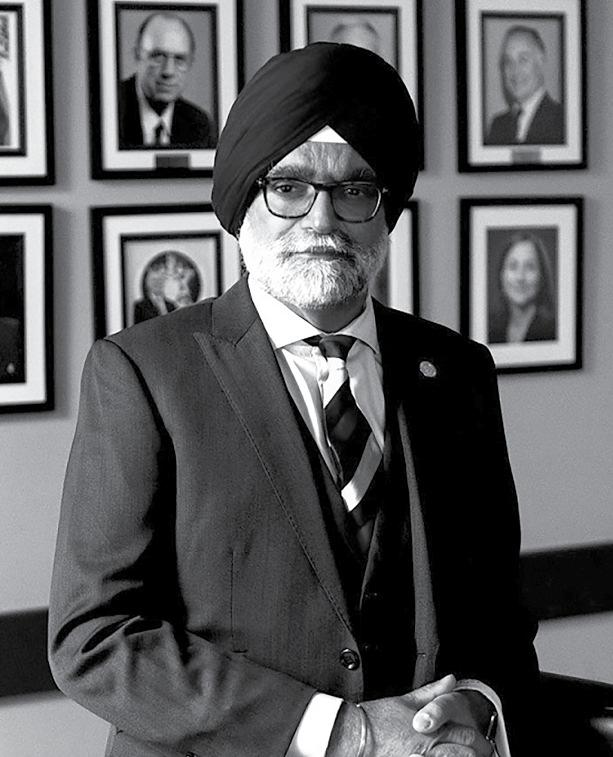
know how to swim. Remember, alcohol and other recreational substances don’t mix with any water activities and intoxication puts you at a significant risk of drowning,” said Brian Twaites, a public information officer with BC Emergency Health Services. “When on or in the water, stay sober and stay safe.”
The second highest cause of drowning occurred during recreational activities such as swimming, accounting for over 18 per cent of deaths. Other activities like boating, including fishing, account for 10 per cent of the causes, with 80 per cent of people who died not wearing a life jacket.
“Adults are a high percentage of drownings,” said Shawn Bourgoin, the City of PortAlberni’s manager of Recreation Services. “Alot of those are due to other factors [like] unsafe activities or consumption of drugs or alcohol or not wearing a life jacket when on water on a boat or a kayak.”
Asurvey from BC Hydro indicates that some British Columbians overestimate their swimming abilities and are not as prepared for safe water use as they believe.Although 85 per cent of British Columbians consider themselves experienced swimmers, most do not practice regularly. Only 63 per cent return to the water during summer, and 85 per cent haven’t taken a swimming lesson in over a decade. Ten per cent have never taken one at all.
This lack of swimming practice is the reason why almost 30 per cent of the B.C. population report having had a neardrowning experience, and 53 per cent have witnessed another person struggling in the water. Similar to previous years, 95 out of 98 drowning deaths from 2024 were residents of British Columbia, with only three victims from out of the province or country.
Recognizing that July is the month with the highest number of water-related deaths, accounting for 20 per cent, the Lifesaving Society chose the third week
of the month as National Drowning Prevention Week (NDPW). Its purpose is to educate communities on the impact of water safety.
Facilities like PortAlberni’s Echo Aquatic Centre and Fitness Studio offer swimming courses for children starting from six months to 15-year-olds. Currently, the facility does not offer swimming lessons for individuals older than 15 years old. However, they had been rebuilding their aquatic team since the COVID-19 pandemic.
“Our goal in the next year or two is to be able to offer [swimming] lessons for young adults and adults.As we know, it’s an example for both children, youth and adults to have in this waterfront community,” said Bourgoin.
Facilities like EchoAquatic Centre are encouraged to run a “How to Survive” challenge, which teaches participants what to do if they find themselves in trouble in the water.Activities include practicing safe water entry, resurfacing, orienting to the environment, and identifying a safe point to reach.
“This is just one way outside of [learning programs to] educate our community members of all ages,” said Bourgoin. For more information about swimming courses at the EchoAquatic Center, please visit: https://playinpa.ca/swimlessons/
CYPRESS RESTAURANT & LOUNGE

Port Alberni Salmon Festival photo
Recreational boats fill theAlberni Inlet. Anew report from the B.C. Coroners Service states that men comprise 77-per-cent of drowning deaths.
Dr. Jatinder Baidwan
Ha-Shilth-Sa newspaper is published by the Nuu-chah-nulth Tribal Council for distribution to the members of the contributing First Nations, as well as other interested groups and individuals.
Information and original work contained in this newspaper is protected by copyright and may not be reproduced without written permission from:
Nuu-chah-nulth Tribal Council P.O. Box 1383, PortAlberni, B.C. V9Y 7M2.
Telephone: (250) 724-5757
Fax: (250) 723-0463
Web page: www.hashilthsa.com facebook: Hashilthsa Ntc
2025 Subscription rates:
Non-Nuu-chah-nulth,Ahousaht, Ehattesaht,Toquaht and Ucluelet members are subject to a yearly subscription fee of $40 in Canada, $50 in the US and $60 for overseas. Payable to the Nuu-chah-nulth Tribal Council
Manager/Editor/Reporter
Eric Plummer (Ext. 243) (250) 724-5757 Fax: (250) 723-0463 eric.plummer@nuuchahnulth.org
Reporter
Denise Titian (Ext. 240) (250) 724-5757 Fax: (250) 723-0463 denise.titian@nuuchahnulth.org
Reporter
Nora O’Malley (604) 353-8488 nora.omalley@nuuchahnulth.org

Audio / Video Technician
Mike Watts (Ext. 238) (250) 724-5757 Fax: (250) 723-0463 mike.watts@nuuchahnulth.org
EditorialAssistant
Holly Stocking (Ext. 302) (250) 724-5757 Fax: (250) 723-0463 holly.stocking@nuuchahnulth.org
DEADLINE:
Please note that the deadline for submissions for our next issue is Aug. 15, 2025
After that date, material submitted and judged appropriate cannot be guaranteed placement but, if material is still relevant, will be included in the following issue.
In an ideal world, submissions would be typed rather than hand-written. Articles can be sent by e-mail to holly.stocking@nuuchahnulth.org (Windows PC).
Submitted pictures must include a brief description of subject(s) and a return address.
Pictures with no return address will remain on file.Allow two - four weeks for return.
Photocopied or faxed photographs cannot be accepted.
COVERAGE:
Although we would like to be able to cover all stories and events, we will only do so subject to:
- Sufficient advance notice addressed specifically to Ha-Shilth-Sa.
- Reporter availability at the time of the event.
- Editorial space available in the paper.
- Editorial deadlines being adhered to by contributors.
LETTERS and KLECOS
Ha-Shilth-Sa will include letters received from its readers. Letters MUST be signed by the writer and have the writer’s full name, address and phone number on them. Names can be withheld by request.Anonymous submissions will not be accepted. We reserve the right to edit submitted material for clarity, brevity, grammar and good taste. We will definitely not publish letters dealing with tribal or personal disputes or issues that are critical of Nuu-chah-nulth individuals or groups. All opinions expressed in letters to the editor are purely those of the writer and will not necessarily coincide with the views or policies of the Nuu-chah-nulth Tribal Council or its member First Nations. Ha-Shilth-Sa includes paid advertising, but this does not imply Ha-Shilth-Sa or Nuu-chah-nulth Tribal Council recommends or endorses the content of the ads.
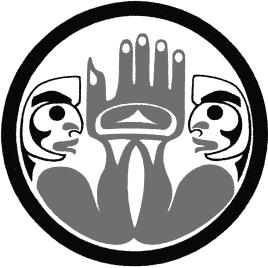
Child welfare report marks anniversary
The overhaul includes ‘supporting families before they find
By Olivia Thomas Ha-Shilth-Sa Contributor
Victoria, B.C. – One year after the harrowing Don’t Look Away report exposed catastrophic failings in B.C.’s child welfare system, the provincial government is highlighting the first phase of its response: a coordinated, cross-ministerial strategy to overhaul how services for children and families are delivered.
The original report, released in July 2024 by the Representative for Children and Youth (RCY), centered on the abuse and deaths of children while they were in government care. The report called for transformational changes to prevent similar tragedies, and focused on the case of Colby, an 11-year-old First Nations boy who died in 2021 while under ministry care. His death resulted to two extended family members each being sentenced to 16 years for manslaughter and aggravated assault.
“Every child in our province deserves safety, belonging, and love, and we must do better,” said Jodie Wickens, minister of Children and Family Development, in a press release issued July 15. “We are working with all our partners toward a renewed model of child well-being that focuses on prevention, care, and supporting families before they find themselves in crisis.”
According to the province, a new Child and Youth Well-beingAction Plan is in development. It will serve as a foundational framework for aligning services across ministries, measuring outcomes, and prioritizing early intervention for vulnerable children. The government also reports it has acted on 65 per cent of the RCY’s tracked recommendations, including key steps in oversight, funding, and Indigenous jurisdiction.
When asked directly what changes are being proposed, and whether they could have prevented the deaths that prompted the report, Ministry of Children and Family Development spokesperson Corinna Filion emphasized the government’s focus on long-term structural change.
“The death of a child is an unimaginable tragedy,” Filion said. “That’s why we’re focusing on real, systemic change to better support kids and families.”
She noted that the ministry has expand-
themselves in crisis’

ed its workforce by hundreds of directservice staff in the past two years, despite a provincewide hiring freeze. More than 81 per cent of the ministry’s $2.44 billion annual budget now goes directly to programs and services.
The ministry is also working to improve internal tracking, such as ensuring children in care are seen by a worker at least once every 90 days, and is boosting support for kinship caregivers. These changes, Filion said, are “only one part of a much broader shift.”
Akey commitment in this broader shift is focused on reconciliation and Indigenous self-determination. The province has now signed 12 agreements with First Nations reclaiming jurisdiction over their own child and family services, with more to come. In a notable move, B.C. also appointed its first Indigenous Child Welfare director, tasked specifically with addressing the overrepresentation ofAboriginal children in care.
Christine Boyle, minister of Indigenous Relations and Reconciliation, reinforced this commitment.
“We hear these calls to action and are committed to continue advancing selfdetermination so that Indigenous children in B.C. are not only safe, supported, and loved, but remain connected to their
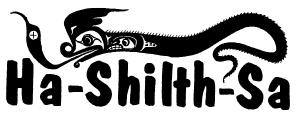
Ha-Shilth-Sa belongs to every Nuu-chah-nulth person including those who have passed on, and those who are not yet born.Acommunity newspaper cannot exist without community involvement. If you have any great pictures you’ve taken, stories or poems you’ve written, or artwork you have done, please let us know so we can include it in your newspaper. E-mail holly.stocking@nuuchahnulth.org. This year is Ha-Shilth-Sa’s 51st year of serving the Nuu-chah-nulth First Nations. We look forward to your continued input and support. Kleco! Kleco!
communities, families, culture, and language,” she said.
In addition to child protection reforms, other ministries are stepping in with complementary strategies. The Ministry of Health is expanding Foundry Centres and Integrated Child and Youth Teams to provide early mental health and addiction support for young people. The Ministry of Social Development and Poverty Reduction introduced a new benefit exemption, allowing families on assistance to retain the full amount of the federal Canada Disability Benefit.
“These services are vital to help young people get back on their feet while our government continues to build a full continuum of mental health and addictions care for everyone,” said Health Minister Josie Osborne.
The RCY has acknowledged the government’s progress, but cautioned that systemic transformation will take time and sustained effort. Minister Wickens agreed, stating, “We are proud of the progress to date, but we know this is just the start and there is much more to do.”
As the province moves forward, both government leaders and community advocates will be watching closely to see whether the promises of change result in meaningful improvements.
Legal Information
The advertiser agrees that the publisher shall not be liable for damages arising out of errors in advertisements beyond the amount paid for space actually occupied by the portion of the advertisement in which the error is due to the negligence of the servants or otherwise, and there shall be no liability for non-insertion of any advertisement beyond the amount paid for such advertisements
Wikimedia Commons photo
“Every child in our province deserves safety, belonging, and love, and we must do better,” said Jodie Wickens, minister of Children and Family Development.
Man’s brain misplaced in hospital after autopsy
A
survivor of Christie residential school, Philip Billy was failed by government systems during life and
By Eric Plummer Ha-Shilth-Sa Editor
Victoria, BC - Losing her father in early 2022,Amanda Large thought the grieving process was behind her - until disturbing news came from the BC Coroners Service last year.
Philip Peter Billy’s brain had been misplaced, and was sitting in the back of a fridge at Victoria’s Royal Jubilee Hospital until it was found more than two years after his death, according to correspondence Large had with the Coroners Service.
Philip Peter Billy of the Ehattesaht First Nation was found unresponsive on Feb. 28, 2022 in his supportive housing unit in Nanaimo.An autopsy concluded that the 55-year-old died the previous day due to bronchopneumonia, a serious infection of the lung, with a severe coronary artery disease that entailed a 90-per-cent blockage.
After Billy’s body was released, the family cremated their loved one in May 2022. Billy’s daughterAmanda was left with Daniel, the youngest of Billy’s five children, whom she had raised since the boy was seven weeks old.Amanda and Daniel decided to put their father’s pictures away, following a cultural practice used by many Nuu-chah-nulth-aht following the passing of their loved ones. By the summer of 2024 some of Billy’s pictures had been brought out again, but emails began to emerge indicating that the grieving process would not be over forAmanda and Daniel.Amessage sent toAmanda from a staff member at the BC Coroners Service warns of “a very serious incident brought to my attention that I want to go over with you”, advising her to “please have a good support system in place as this will be some hard and frustrating news.”
The Coroners Service toldAmanda that her father’s brain was not with the body when it was cremated, as she had been originally told. Rather, it was still at the hospital in Victoria.
“When it was received by Royal Jubilee Hospital it was misplaced in a fridge and not returned to the body,” stated an email from the Coroners Service. “It was found now while the fridge was being cleaned out.”
“He was supposed to get a second brain autopsy. It never happened,” said Amanda.
“It was very traumatic. I went into nervous shock for two months. I couldn’t sleep,” she added, noting that by early December she fell into a deep depres-
death

sion. “I felt like my dad had died all over again, and it was just much more horrific. He didn’t get to die with dignity.”
Philip Peter Billy did not have an easy life.As a child he went to Christie Indian Residential School, where he was abused, according to what he disclosed to Amanda when she became an adult. Billy struggled with alcohol through his life, and apologized to his daughter for not always being there when she was growing up.
“He was a part of my life, but he wasn’t always there 100 per cent of the time,” saidAmanda.
In 2017 Billy had a run in with the police in Nanaimo, which resulted in him being so severely beaten he was hospitalized, recallsAmanda.
“He was riding a bus, I guess he was drunk. They took him and wanted to arrest him. I guess he had one handcuff on and he wasn’t really letting them,”

she said. “That really took his health away when the police beat him. He was accused of something, and he was never charged.”
Billy sustained a brain injury, had mobility issues that required the use of a walker or wheelchair, and developed a speech impairment after the incident.
His autopsy notes a history of illicit drug use as well as prescription opioids.
“He had to have a walker,” saidAmanda. “He just wasn’t able to keep his health.”
The daughter wanted to pursue legal action against the RCMP after the police incident, but Billy asked her to let it go. But she’s not willing to forgive this recent misplacing of her fathers brain, and has filed a lawsuit against the BC Coroners Service and Island Health for their handling of Billy’s body at the hospitals in Nanaimo and Victoria. Both govern-
ment agencies have declined to comment on the case, as it is before the courts.
“He had a hard life,” reflectedAmanda, looking back to her father’s start in residential school. “He was failed by that system, he was failed by the public safety system and he was failed by the medical system after his death.”
Billy’s brain has been cremated, and the family employed the services of Tla-oqui-aht elder Levi Martin to perform a cultural reunification of the brain and body ashes. Billy’s pictures were also taken down a second time.
“I do think of him quite often,”Amanda admitted. “Raising Daniel, he has a lot of the attributes of my dad, the way he walks and the things he does.”
“He’s still very much a part of our lives,” she continued. “We did take all of his pictures down, but we put them back up.”
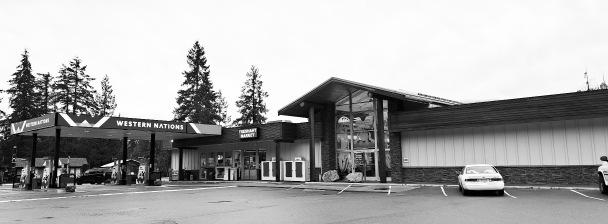

Submitted photo
Pictured with his daughterAmanda Large, Philip Peter Billy died in 2022, but the family found out more than two years later that his brain had been misplaced after the autopsy and was not cremated with the body.

Hesquiaht crew launches canoe for Paddle to Elwha
The First Nation’s team of mostly women embarks on 350-kilometre paddle destined for the Olympic Peninsula
By Nora O’Malley Local Journalism Initiative Reporter
Hesquiaht Harbour, BC – In the early morning of Sunday, July 20, a Canadian crew of mostly Indigenous women pushed off from the shores of Hesquiaht Harbour, marking the start of their roughly 350-kilometre Paddle to Elwha 2025 Canoe Journey.
Navigating the highway of their ancestors, the Hesquiaht First Nation’s crew of eight planned to land on the shores of the Elwha Klallam Tribe on the north coast of the Olympic Peninsula in Washington, U.S.A. on July 31.
“The reason why to leave early is I want to stay ahead of the wind,” said Hesquiaht Hereditary Chief VinceAmbrose, the crew’s skipper who sits at the back of the canoe. “Usually, it picks up later on in the morning. It’ll be a good wind. We’ll be going with it. It’ll be a westerly, northwest. It’s not going to be a big wind either. That’s what I was hoping for, good weather conditions.”
They travelled from the farthest distance to join thousands of paddlers and over 100 tribal canoe families from across the Pacific Northwest for the region’s biggest Indigenous event of the year. Following the July 31 landing, there was five days of protocol and celebration.
Hesquiaht’s first stop on their canoe journey was about a four-hour pull to the neighbouring Hesquiaht community of Hot Springs Cove. Then they planned to stop in the Nuu-chah-nulth traditional territories ofAhousaht, Tla-o-qui-aht, Yuułuʔiłʔatḥ and Huu-ay-aht.
“Because of the remoteness of our area, two or three of our crew couldn’t make it so we will pick them up along the way. That’s usually how it works. We pick up spares as we’re going,” saidAmbrose.
“By the time we reach Huu-ay-aht, my crew is pretty exhausted, so any help we can get is nice.”
Ambrose says the Paddle to Elwha is a fairly short journey compared to the others he’s been on. In 2017, he paddled over 700-kilometres from Hot Springs Cove to Campbell River on the east side of Vancouver Island.
“I guess you could say I’m addicted to tribal journeys,” he said. “For the most part, I’m usually on a healing journey. Anybody that joins us is usually doing this for their healing journey. It helps not just myself, but other family members. Anybody that is going through a hard time it helps them a lot.”
Hesquiaht embarked on the Paddle to Elwha with both a support boat and vehicle. The team spent one or two nights camping at each nation they visited, and some of the crew that paddled also switched and helped the road crew or support boat.
Ambrose says it’s heartwarming to pull into each different nation and spend time with them.
“The Chief and all their members are singing their songs before we even land on the beach. It makes our people feel really good,” saidAmbrose.
He’s unsure as to why his Hesquiaht crew, including Stephanie Charleson, CoraAmbrose, Carol-Anne Lucas and Kayla Lucas, are mostly women.
“That’s how it’s been pretty much every year,” saidAmbrose. “My most reliable ones are female. I don’t know why that is. I have no idea. There has been interest from our male members, but when it comes down to it, it’s whoever shows up. If you’re there, you’re always welcome to help us get from pointAto point B.”
Stephanie Charleson said she was looking forward to paddling with a wonderful crew from Hesquiaht homelands in a traditionally styled dugout canoe.
“The feeling of being in the cupac is so ancestral, no words, the calmness, the excitement all in one, it’s like going back in time, a trance how my body just knows cause it’s in our DNA,” said Charleson.
The theme for the 2025 Paddle to Elwha is, “Dams Removed-ARiver RebornSpirits Renewed”, and the event honours the legacy of Paddle to Seattle, a tribal journey hosted in 1989 that brought Indigenous communities from the Pacific northwest together, re-awakening the traditional practice of travelling in dugout canoes and carving canoes.
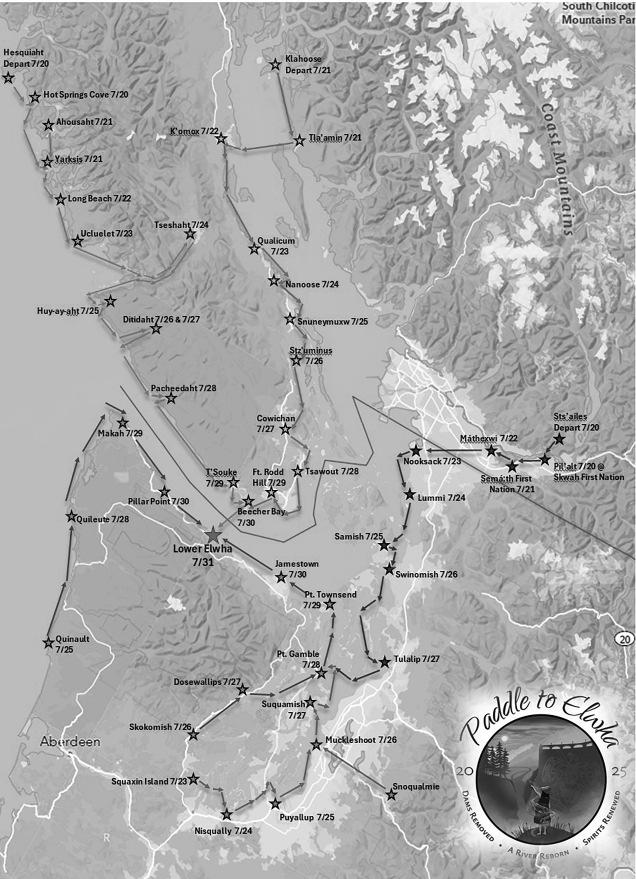
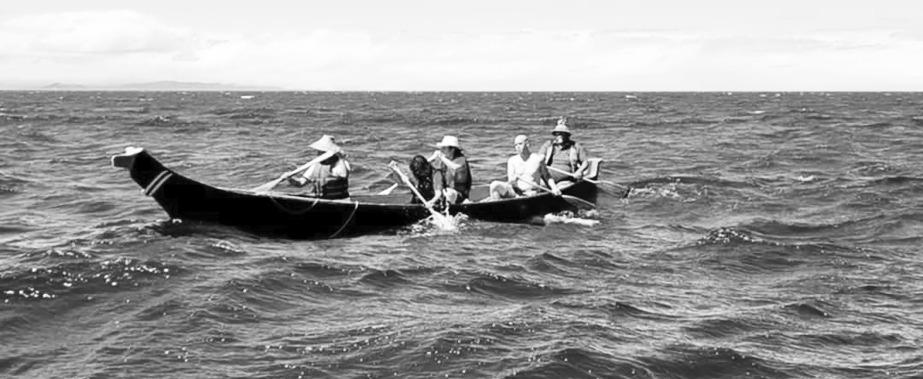
Paddle to Elwha photo
This summer groups from across the north Pacific coast travelled by canoe to the Olympic Peninsula, where a gathering was hosted by the Elwha Klallam Tribe.
Steve Titian photos
Hesquiaht First Nation members embarked on a tribal journey to Lower Elwha on July 20. They travelled the way of their ancestors, navigating down the Northwest Coast with a traditionally designed dugout canoe.
Yuułuʔiłʔatḥ welcomes canoes during journey
Yuułuʔiłʔatḥ Government pull support two days before their crew was meant to depart, citing liability concerns
By Nora O’Malley Local Journalism Initiative Reporter
Hitacu, BC –After a 7:30 a.m. push off from Long Beach on July 23, three Ahousaht canoes and one Hesquiaht canoe cruised into the Yuułuʔiłʔatḥ (Ucluelet First Nation) community of Hitacu around 1 p.m.
On their way to Hitacu Hesquiaht skipper VinceAmbrose said his crew of mostly women hugged the shoreline while the otherAhousaht canoes went offshore.
“It was easy pulling. There was no wind. The ocean was pretty calm,” said Ambrose on day four of a 12-day canoe journey.
Their destination was to reach the Elwha Klallam Tribe by July 31 for a Potlatch with over 100 tribal canoe families from all over the Pacific northwest.
“We are tired. It’s been a long pull from Hesquiaht, our number one reserve, to Hot Springs,” saidAmbrose.
As part of the landing protocol, one member from each canoe asked for permission to come ashore to rest, share songs and food.
Yuułuʔiłʔatḥ community member Skylene Patrick welcomed the weary pullers to their territory and invited them to make themselves at home.
“We admire the traditional healing and work that your communities and nations are doing. The work that you are doing is tying you to the land, to the water, to our people,” said Patrick. “We aspire to be paddling a Yuułuʔiłʔatḥ cupac (canoe) alongside you one day.”
Yuułuʔiłʔatḥ had a canoe family preparing for the Paddle to Elwha journey, but Yuułuʔiłʔatḥ Government (YG) pulled their financial support two days before the crew was meant to depart citing “safety and liability concerns”.
In a July 23 letter, YG President Charles McCarthy stated that “due to concerns for the safety of Yuułuʔiłʔatḥ citizens and staff, the YG Executive has made the difficult decision not to sanction or endorse this year’s event.”
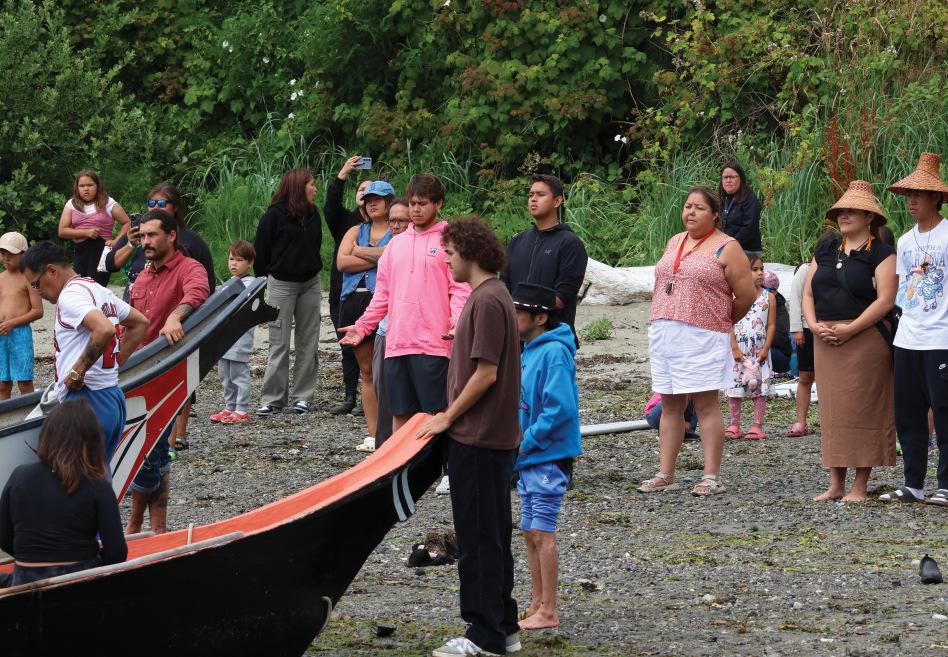
“I’m angry. What message is this sending to our children and youth? It’s not our way to focus on policy and procedure,” said Yuułuʔiłʔatḥ community member Anita Charleson-Touchie.
“Just knowing the devastation, I’ve watched many young people prepare for months. I’ve seen one of our teenagers making her way to the canoes at six in the morning and watched my son prepare paddles, he’s devastated. He’s heartbroken. I just know that it’s not right to withdraw on such a short notice,” she continued.
Charleson-Touchie, alongside dozens of other Yuułuʔiłʔatḥ citizens, made it down to the beach to welcome the other nations, despite the last-minute news from
their own government.
“I’ve been raised with the values of help one another. That’s why I came. I want to be a good host,” said Charleson-Touchie.
“It’s deflating for sure. We will take care of our guests and do what we can. What’s resonating is the teaching of late Richard Mundy who always reminded us that we come from a loving people and that’s what I’ll hold in my heart.”
Sam Chester, who is of Ditidaht First Nation and Keltsmaht descent, spoke on behalf of the ‘Flying Monster’canoe family fromAhousaht.
“We consist of paddlers from all different nations. We even have a Mohawk with us,” said Chester.
“Journeys is a lot of things to a lot of
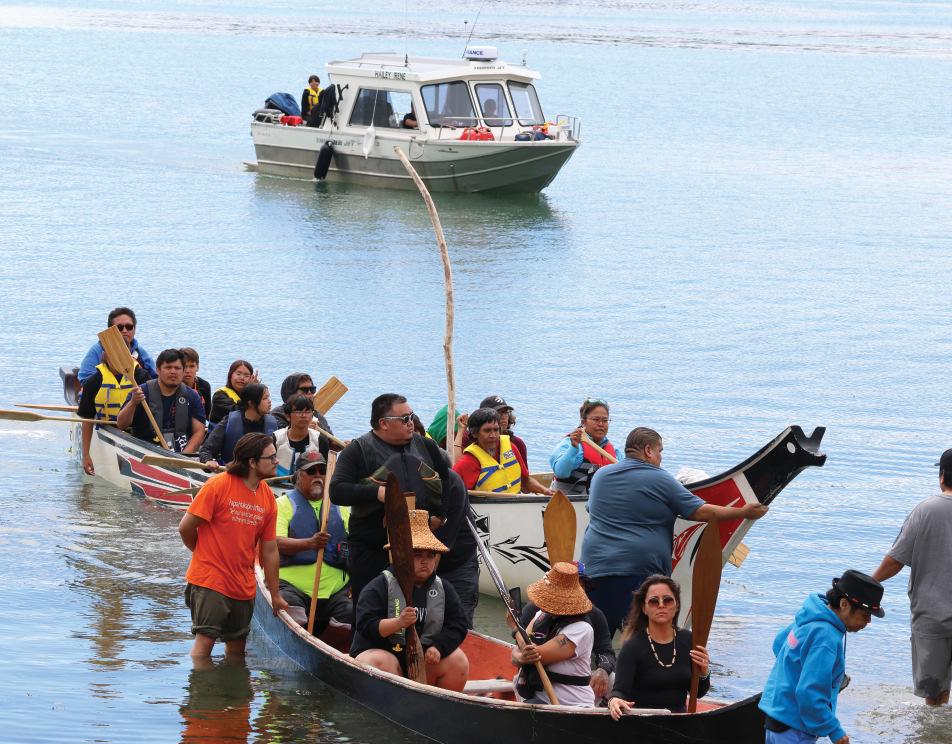
people.Alot of people do it for different reasons.Alot do it to deal with drugs and alcohol and loss of a loved one and strengthen themselves and grasp life back.Acouple of the girls with me, they lost their mother, so they come to heal,” he shared.
Nitanis Desjarlais watched her son Cheveyo Seitcham, 15, ask for permission to come ashore in Hitacu.
“He’s going all the way. His older brother gave up his seat and he will be on the land crew. He just jumped on,” said Desjarlais, adding that she’s been scrambling to round up camping gear.
Ahousaht sent three canoe families and one youth canoe to Elwha this year.
“This means a lot to us. Physically being on the ocean, there is so much healing. It’s not the ocean that separates us, it’s the ocean that connects us. Through the ocean highways connecting our communities in a cultural way is the best feeling,” she said.
One of theAhousaht canoes and support boats were blessed with a visit from kakawin (killer whales) on the pull from Long Beach to Hitacu.
“This will be lifetime transformable memories that is going to connect them to their nation,” said Desjarlais. “That cultural pride and that DNAmemory being activated is really going to set some solid foundation for them.”
Ahousaht member Daniel Frank, 61, was on a support boat for his nephew Russell Frank Jr. He followed the Ahousaht youth boat to Elwha.
“I did it for sobriety,” says Frank of his past Tribal Journey to Lummi. “There is no drinking allowed. It’s better than being out drinking.”
The next stop for the Hesquiaht and Ahousaht canoe families was a night at the Broken Group Islands, then they continued on to Huu-ay-aht First Nations traditional territory.
“After Huu-ay-aht there are going to be three really long pulls. Ten-hour days. We’re hoping for good weather. My hands are fine. I’ve been fishing, so I have callouses,” said the Hesquiaht Hereditary Chief VinceAmbrose.
Nora O’Malley photos Hesquiaht andAhousaht pullers ask for permission to come ashore in Hitacu on July 23, where Yuułuʔiłʔatḥ people await.
25 years later, House of Huu-ay-aht marked a time when the nation
Inspired by the remains of the ancient village and fortress of Kiixʔin, the ambitious project was the first longhouse built in Huu-ay-aht
By Eric Plummer Ha-Shilth-Sa Editor
Anacla, BC - On a busy Saturday afternoon inAnacla, Charlie Clappis sits by the entrance to the House of Huu-ay-aht looking up at the massive structure he worked to build a quarter century ago.
“It’s just so grand. So grand,” reflects Clappis, looking at the cedar posts supporting four gargantuan spruce logs that extend across the ceiling of the structure.
Clappis was among a handful of Huu-ayaht members who were hired as labourers to help in what would become the first longhouse built in the First Nation’s territory in over a century.
“I started in November, and it was windy and rainy,” he recalled, noting that the most challenging task for the crew was figuring out how the spruce logs would be supported.
This led Clappis to wonder how his ancestors handled such dimensions without modern machinery.
“They had two 80-ton cranes to lift these,” he said of the equipment used by Knappett Construction at the site 25 years ago.
“It involved a lot of mathematical theory to put the poles in the right places,” said lead carpenter Herb Nelson in a document from the First Nation. “The top four logs each weigh around 30 tons, so everything has to fit just right to hold the 108 and 118-foot-long spruce logs up there.”
On July 26 the First Nation celebrated 25 years of the House of Huu-ay-aht serving as a central gathering place for the First Nation, an event that filled the big house with song and feasting, with hours of cultural performances by Huu-ay-aht and other Nuu-chah-nulth nations.
When the structure was built it was a transitional time of the First Nation, as what would become the Maa-nulth Final Agreement was developing. Implemented in 2011 for five Nuu-chah-nulth nations, Maa-nulth is among the few modern-day treaties that has been enacted between the governments of British Columbia, Canada and First Nations.
“This building was created at a time when Huu-ay-aht turned a corner,” said Huu-ay-
aht Chief Councillor John Jack. “We were in the middle of negotiating a final agreement that would ultimately result is us having self-government and ownership control of a portion of our lands.”
Since then the building has served a variety of purposes, including hosting citizens’ assemblies, meetings with different levels of government, cultural events, as a well as countless ball hockey and basketball games for residents ofAnacla and neighbouring Bamfield.
When the House of Huu-ay-aht originally opened in July 2000, the late Tyee ƛiišin, Spencer Peters was quoted in a Ha-ShilthSa article to say it was the greatest day of his life.
“He always dreamt of having a place where we can conduct business with the chiefs, elected council and community,” said Robert Dennis Sr., who was Huu-ayaht’s elected chief when the long house opened.
At the time the First Nation had been without a gathering facility for a few years, after a hall in lowerAnacla was torn down.
“We had a small hall down at the lower village that wasn’t suiting our needs,” said Huu-ay-aht elder Jeff Cook. “It was deteriorating so we tore it down. We were without a hall back then.”
The original plan was to construct the long house in lowerAnacla, where multiple homes had been built. But some warned of the risk of a Tsunami, recalling an event in early 1700 that devastated a Huu-ay-aht village at Pachena Bay. This led to the higher ground of upperAnacla, making the House of Huu-ay-aht an emergency destination for the village in the event of a tsunami.
Inspiration for the structure’s design came from the remains of the ancient village and fortress of Kiixʔin on the coast of Barkley Sound. Kiixʔin is designated a National Historic Site for demonstrating continuous occupation in the area for almost 3,000 years, according to Parks Canada. The site has been unoccupied since the 1880s, but was once a central settlement for Huu-ayaht people.
For 39 years Stella Peters led tours to Kiixʔin.
“The village site out there is 5,500 years
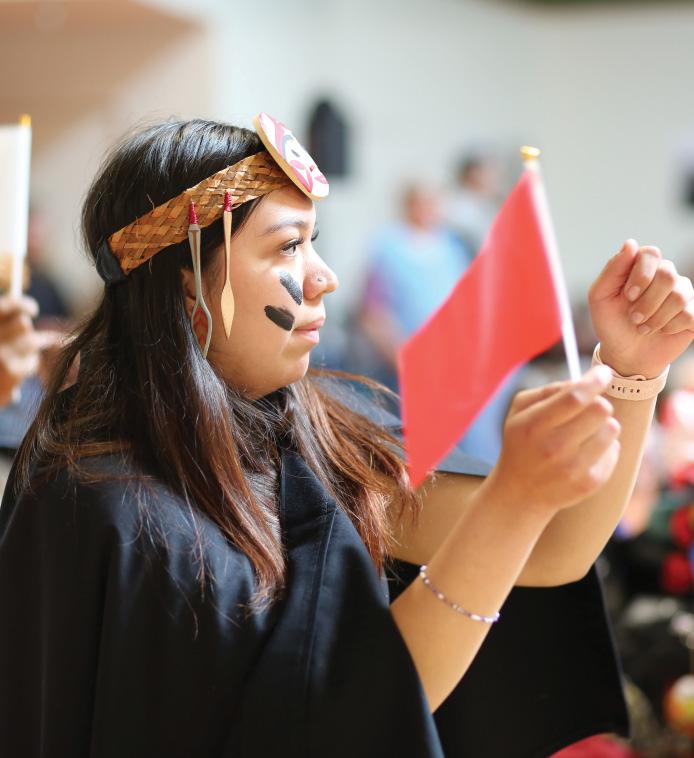
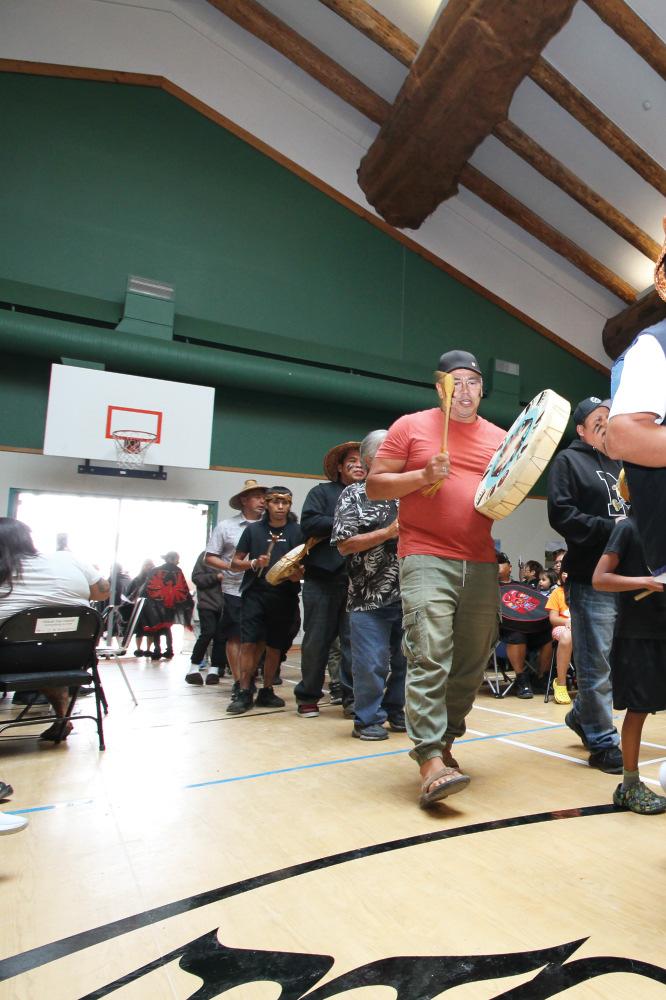
On July 26 the House of Huu-ay-aht filled with the First Nation’s members and guests to celebrate 25 years held inAnacla, located near Bamfield in Barkley Sound old,” said Peters, who is now a Huu-ay-aht councillor. “It connects us to our history, our past.”
In front of the House of Huu-ay-aht stands carvings of Ho-mini-ki, the first woman, and Nutchkoa, the first man, copies of giant figures that once stood before a long house at Kiixʔin and are now at the lobby of the Royal B.C. Museum in Victoria.
With posts and beams still visible, the lead architect for the House of Huu-ay-aht
was brought to Kiixʔin to guide the design. As is usually the case with traditional Nuuchah-nulth villages, posts and beams at Kiixʔin were made from cedar, but a different approach had to be taken for the House of Huu-ay-aht.
“Because of the building codes nowadays we weren’t allowed to use cedar so we used spruce instead,” said Cook, who worked for MacMillan Bloedel when the house was built in 2000.

when the nation ‘turned a corner’
longhouse built in Huu-ay-aht First Nations’ territory in over a century
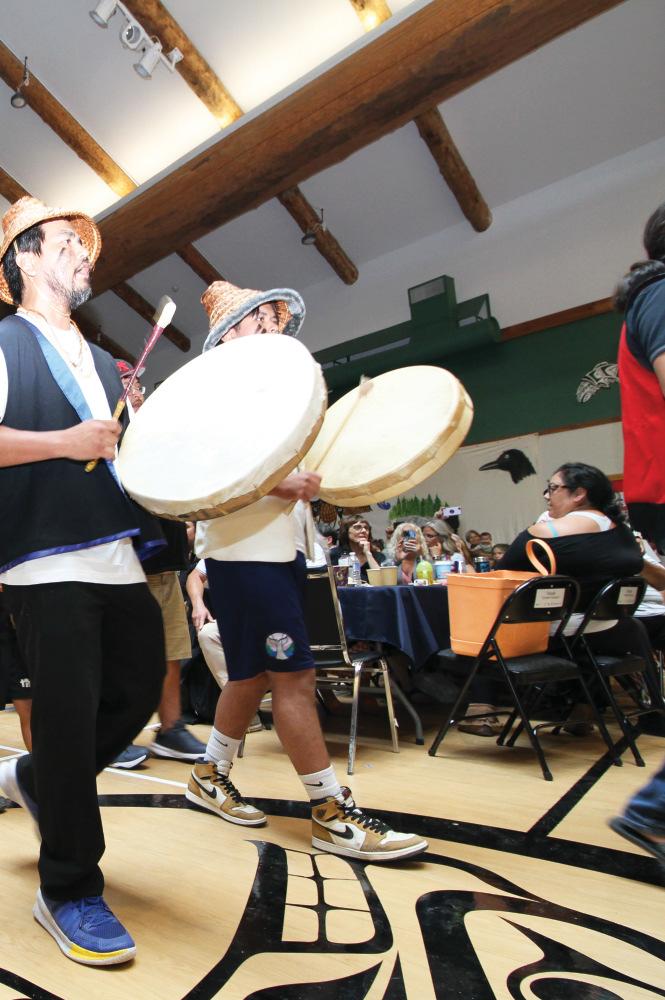
Eric Plummer photos members and guests to celebrate 25 years since the modern-day longhouse was completed. The event was
to guide the design.
with traditional Nuuposts and beams at , but a differtaken for the House
building codes nowadays
use cedar so we used Cook, who worked when the house was
Measuring over 130 feet long and five feet wide, the spruce roof logs were harvested from the Klanawa watershed through an agreement with the Ditidaht First Nation. They were cut and hauled by MacMillan Bloedel, part of what amounted to half a million dollars worth of donated equipment usage, volunteer time and materials from the forestry company, estimated Cook. Two of MacMillan Bloedel’s logging trucks had extra trailers added to haul the logs, which
even so hung 60 feet off the end. What would normally have been a three-hour trip from Klanawa toAnacla ended up taking 16 hours due to the expanse of the load.
But the trucks couldn’t turn into upper Anacla, recalled Cook.
“We couldn’t get around the corner, so we had to unload them there and leave them overnight on the side of the road,” he said of the spruce logs. “We used a big hydraulic grapple on one end, and a caterpillar

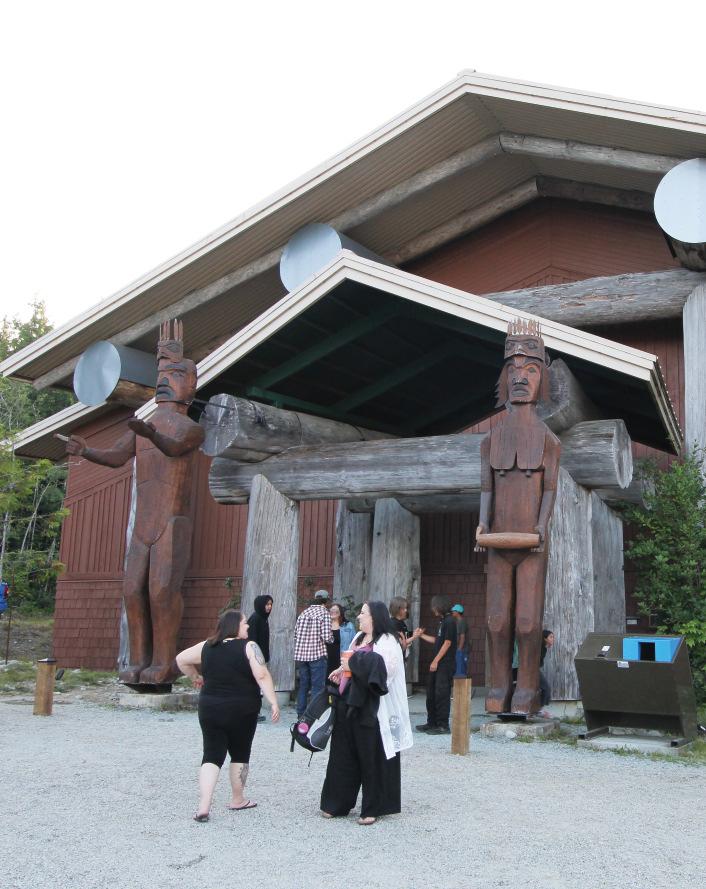
Over the last 25 years the House of Huu-ay-aht has become a community hub for Anacla, while also hosting government meetings and important cultural events.
on the front end with an arch on it. We dragged it all the way from the mainline down below there, packed it up to here.”
At an approximate cost of $2 million, the building’s construction was funded by the First Nation, which used the House of Huu-ay-aht as a mark of self-determination beyond federal government reliance.
“We come from an oppressive culture where everything was done for us. It’s now time to do things for ourselves,” said Robert Dennis Sr. “I had a grandfather who, when he wanted to build a boat, he didn’t ask the government for money to build a boat. He went and cut the trees, cut the timber and built a boat.”
The 25th anniversary celebration also
served as an official reopening for the House of Huu-ay-aht, which until recently was closed for six months to allow for kitchen and washroom renovations, a new wooden floor, painting and the installation of a back up generator.
Since the longhouse was completed in 2000, the surrounding neighbourhood in upperAnacla has grown from one house to over 20. Now the First Nation hopes to build a daycare, youth centre and cultural facility next to the big house.
“That’s what we’re negotiating with Canada and B.C. right now,” said Huuay-aht Executive Director Karen Haugen.
“The design is going to mimic what we see with the House of Huu-ay-aht.”
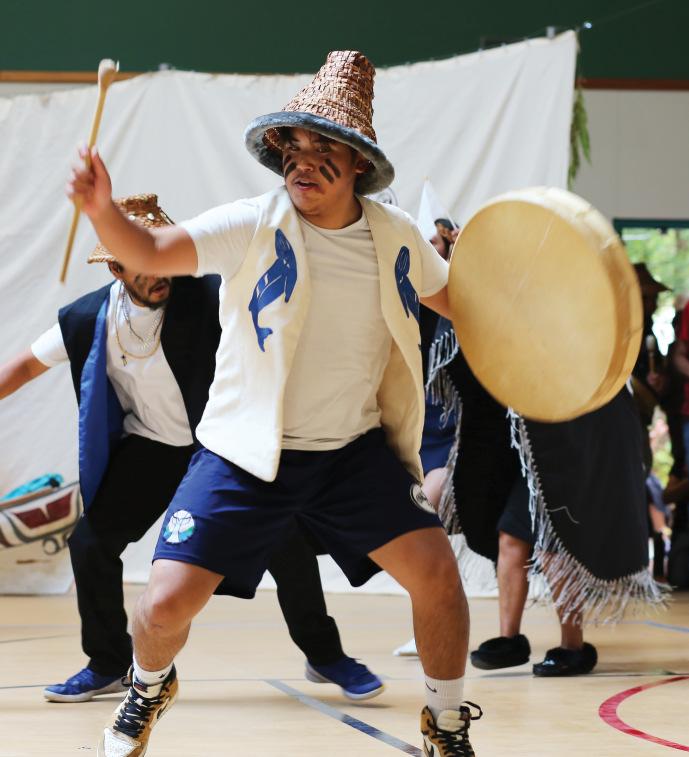
Flag raised at Tofino town hall for Tla-o-qui-aht Days
Week of festivities began with a parade through the tourist town followed by a TFN beach day and camp out
By Nora O’Malley Local Journalism Initiative Reporter
Tofino, BC – Tla-o-qui-aht Days festivities kicked off on Monday,Aug. 4 with a mid-morning parade through the streets of downtown Tofino and flag raising ceremony in front of the municipal building.
Tla-o-qui-aht Tribal Parks led the group to the Village Green while Tourism Tofino cruised at the back of the community parade with both their old-school 1966 VW van and their new electric VW ID. Buzz.
After a traditional Welcome Song was performed, Tla-o-qui-aht First Nation (TFN) Chief Councillor Elmer Frank thanked the crowd on behalf of the Ha’wiih (Hereditary Chiefs) for coming out to celebrate Tla-o-qui-aht Days.
“It brings our people together and it brings our community together,” said Frank.
Tofino sits on unceded traditional territory (Ha-Hoothlee) of the Tla-o-qui-aht. The First Nation was a whaling society and known as the Cedar Salmon People, governed by the laws of ʔiisaak, meaning respect, his-shuk-nish-tsa-waak, meaning everything is one.
“When we first started talking about reconciliation, maybe 10 years ago, the government came with this new word, saying that they wanted to do reconciliation. So, I asked the government, ‘When did we ever really have a relationship? When did we have a relationship to call it reconciliation?’,” said Frank.
“Agovernment that sadly treated us badly. You’ve heard about the Hudson Bay blankets, you’ve heard about residential schools, the Sixties Scoop, you’ve heard about these negative things that we were able to survive. We were able to survive because people in our communities knew how to protect our Ha’wiih and our musčum,” Frank continued. “That’s why it’s a great day for us today. Today is a true sentiment that shows we are not going anywhere, we are all committed to working together, celebrating days like this together; continue to look ahead and continue to support each other to heal together.”
In the early 1800s, Tla-o-qui-aht warriors protected Clayoquot Sound

fromAmerican invasion and forty-one years ago, TFN, with support from the Nuu-chah-nulth Tribal Council (NTC), famously declared Meares Island the “Wanachis Hilth-huu-is Tribal Park” under Nuu-chah-nulth law.
The Meares Declaration protected the old-growth forest from being logged, and is recognized as one of the largest demonstrations of civil disobedience in North America. Prior to the conservation stance, there was no “tribal park” in existence under provincial or federal legislation.
Today, Tla-o-qui-aht’s Tribal ParkAllies program connects about 130 Tofino businesses with TFN to contribute to the common goal of restoring and protecting our shared home for future generations.
Tofino Mayor Dan Law was invited to speak during the Tla-o-qui-aht Days opening event.
“Not only is it an honour and a pleasure to be here to celebrate Tla-o-qui-aht First Nation, it is my duty,” said Law, noting that the flag raising ceremony was a gesture to recognize “truth and to work
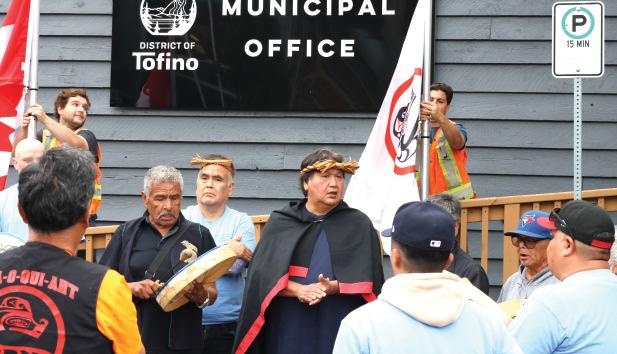
Tla-o-qui-aht First Nation and the District of Tofino raise three flags – Tla-oquiaht, Canada and B.C. – outside the municipal office onAug. 4.
together in the spirit of friendship.”
“It’s my sincere hope, and with purpose, that we walk together shoulder to shoulder for the benefit of all people,” he said.
Following the flag-raising ceremony, Tla-o-qui-aht hosted a community barbeque and TFN member Saya Masso
Phrase†of†the†week:†+uupic^†%imc^apup
Pronounced ‘Tlu piich alt im cha pup’, it means ‘Summer Games’Supplied by ciisma.
shared stories about the nation’s history. Kids participated in culture, dance and a bouncy castle.
Tla-o-qui-aht Days runs all weeklong with a beach day at Esowista near Long Beach onAug. 5 and family camp out on Ookmin in Clayoquot SoundAug 6 to 8.

Nora O’Malley photos
Tla-o-qui-aht language keeper Deb Masso paddles with the mułaa, rising tide surf team float during the TFN Days parade.
Illustration by Koyah Morgan Banke
Yuquot celebration marks return of whalers shrine
Contents of long-removed Whalers Washing House now await placement by First Nation to a secret location
By Eric Plummer Ha-Shilth-Sa Editor
Yuquot, BC -Agrey whale came to the shore of Yuquot onAug. 2, exposing its fins above the surf as the massive animal rolled against the pebbled floor below the surface. The visitation seemed appropriate, as a celebration was underway on the site of the ancient Mowachaht village, where societies subsisted off the passing cetaceans for thousands of years.
“It’s magical for some of you; for some of us, it’s natural,” said Yahtloah, Tyee Ha’wilth Mike Maquinna, about the presence of the whale, before a crowd of over a hundred members of the Mowachaht/ Muchalaht First Nation and dozens of guests.
Many of the First Nation’s members had been camping at the site, while others came for the day to celebrate the 33rd Yuquot Summerfest, an annual event held at the Mowachaht’s former village site on the southern shore of Nootka Island. This year the big topic of discussion was the return of the Whalers Washing House, a shrine that was finally returned to Yuquot this spring after sitting in the storage of theAmerican Museum of Natural History for 121 years. In late March the contents of the shrine, which includes 88 carved human figures, four wooden whales and 16 human skulls, were packed up and sent from the New York museum to Yuquot, where they remain in crates awaiting transport to their final location. The First Nation plans to undertake this task over the coming year.
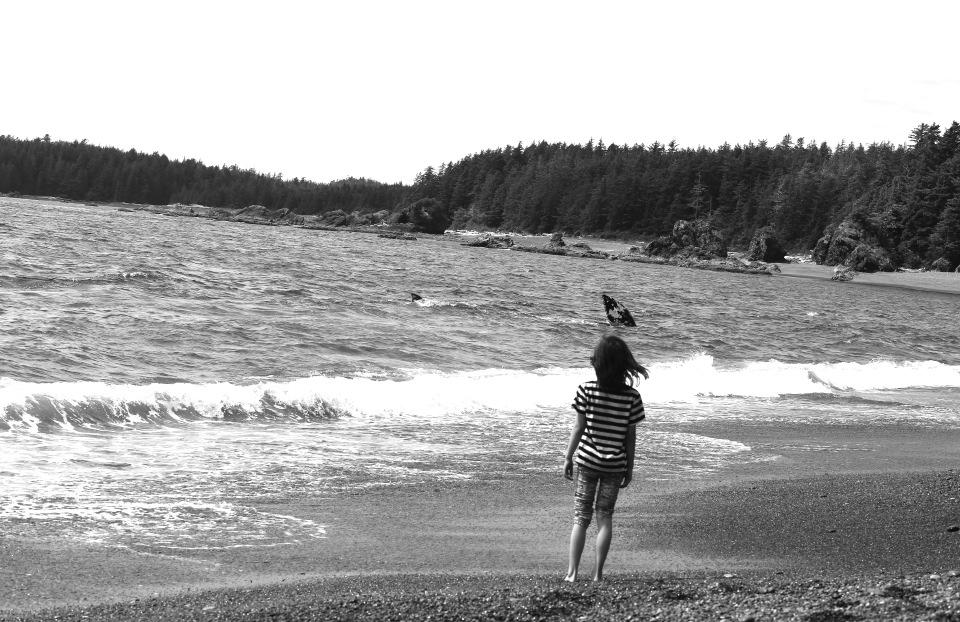
condition that the sacred items would be collected while the rest of the village was away on a seal hunt. This purchase was made for the New York museum as it was building its collection from the lives of Pacific coastal peoples.After it arrived at theAMNH the following year, the shrine’s contents would remain in storage, never to be exhibited.
Muchalaht member Joni Johnson. “I think this is going to bring us and push us forward in doing many more great things together.”
“Now that it’s home we have to decide how we’re going to get it to its original site,” said Maquinna of the sacred contents, which originally were arranged in a secret location on Jewitt Lake.
Very little is known about the Whalers Washing House, as before it was moved in 1903 it was only used by whalers for purification rituals involving a connection to their forefathers. This was a critical part of how they prepared for the hunt.
Somehow George Hunt, a Tlingit-English ethnographer, came across the shrine during his travels.According to historical records from the time, he arranged for the purchase of the shrine with two elders from Yuquot for the fee of $500 – on the
Margaretta James is president of the Land of Maquinna Cultural Society. She said some Mowachaht/Muchalaht chiefs and elders were brought to the museum in the 1980s to see the shrine, some of whom didn’t even know that it existed.
“The museum wanted to replicate it and display it, but that never happened,” said James, noting the longstanding resistance from the First Nation to present the Whalers Washing House to the public.
Many believe that such exposure would rob the shrine of its power, a devastating gesture for a community that has already suffered from the removal of a foundational element of its spiritual lifeblood.
“Bringing our ancestors home is a powerful, powerful thing,” said Mowachaht/
The need to return the whalers shrine has long been a desire of the First Nation, and was identified in the YuquotAgenda Paper, a document that the First Nation submitted to the Historic Sites and Monuments Board of Canada in 1997 to gain Yuquot recognition as a National Historic Site. But for decades a consensus couldn’t be reached of how exactly repatriation would occur, until a committee was formed last year.
This group included the new additions ofAlbert andAlex Lara, a father and son duo from Sacramento, California. Through DNAanalysis and the research of church recordsAlbert found himself to be a distant relative of the Maquinna family, several generations after the Mowachaht chief’s daughter and son left Yuquot on a Spanish ship during the late 1700s. They somehow made their way south to California, where Maquinna’s daughter, Izto-coti-clemot, carried the


lineage by marrying and having a son.
Having discovered this ancestral relation, the Laras were eager to help. They soon found themselves to be mediators between the First Nation and the museum, drawing on their experience from business and dealing with Indigenous groups in the USA.
“We were able to identify what needed to be done with some actual timelines, really drive it, pull everyone together, be on weekly calls,” saidAlex of his involvement. “The desires of the nation and an organization like the museum, there’s some challenges there. It required, I think, some more neutral mediation. I think that was very key in our first meeting in July.”
“We’re here on behalf of our great ancestors to help in any way,” saidAlbert, as he was on the boat with his son to celebrate at the Yuquot Summerfest. “It became apparent when we found out about how we were related to the nation here, that brought up another type of sense of the human spirit within ourselves. To find out that we could be a part of it in helping, it was the DNAtalking within ourselves from our ancestors here to say, ‘Do it’.”
The father and son also acknowledge that the repatriation reflects a broader change among museums regarding the rightful placement of sacred items that might have been removed under suspicious circumstances.
“It’s all about a change in attitude in museums,” said James to the crowd gathered in Yuquot.
“One of the first questions they asked us right away was, ‘What are you going to do with it?’,” she continued. “What I say today is, none of your business.”
Mike Maquinna
40th annual Tlu-piich Games slides into Port Alberni
This year’s program features track and field, slow-pitch, pool games, three-on-three basketball and canoe races
By Nora O’Malley Local Journalism Initiative Reporter
PortAlberni, BC – Time to batter up, Nuu-chah-nulth! The 40th anniversary of the Tlu-piich Games is coming to Port AlberniAugust 11 to 14.
Hosted by the Nuu-chah-nulth Tribal Council, the annual Tlu-piich (meaning summer) Games is all about bringing communities together for friendly sports competition, culture and fun times.
“We finally got the swimming pool back this year. Every year it’s been closed because of maintenance. We’re going to have races, toddler swim and water basketball,” said Tlu-piich Games Operations Co-ordinator Deanna Samuel.
“I’m looking forward to a lot of people being happy and just enjoying the games,” she said.
To celebrate the 40th milestone, athletes will receive a goodie bag this year, teams can camp at the Fall Fair Grounds, and the organizing committee is doing their best to make sure community needs are met.
“We’ll have anAthlete Station for people to cool down and we’re inviting food vendors so players don’t have to leave to come eat,” said Samuel.
As ofAugust 1, five nations had confirmed their attendance: Ditidaht, Tlao-qui-aht, Tseshaht, Hupacasath and Huu-ay-aht. Samuel hopes more nations will join the fun.
“Way back when it was the Indian Games we would have the whole Vancouver Island out participating, and it was huge. It was two weeks. I remember everything was full,” said Samuel, who is from Ditidaht First Nation.
The Indian Games used to include a Miss Nuu-chah-nulth Beauty Pageant and a sober Teen Dance, but over the

Plummer photo
Boys await the starting gun during a race at the Tlu-piich Games in 2024. This summer the games take placeAug. 11-14 in different venues in PortAlberni.
years funding and staffing for the games dwindled, so the mid-August event became smaller.
The 2025 Tlu-piich Games program features track and field on Monday, slow-pitch and pool games on Tuesday, 3v3 basketball on Wednesday and canoe races plus volleyball at Canal Beach on Thursday.
There is also bingo on Monday night at the Italian Hall and a culture/wellness
Les Sam Construction
Ph/Txt: 250.720.7334 les sam@shaw.ca

Looking for......
Usma Nuu-chah-nulth Family and Child Services are looking for individual/s or families who are interested in caregiving for teens with high-risk behaviors.
The Caregiver(s) would provide 24-hour care in a culturally safe and suppor!ve environment, responding effec!vely to challenging behaviours.
Compensa!on would be built around the specific needs of the youth and the Caregiver, and could include both direct services and financial support to allow Caregivers to meet the needs of the youth.
For more informa on, please call Joni or Julia at 250-724-3232.
night on Thursday at Italian Hall. The opening ceremonies are 5:30 p.m. at Bob Daily and the closing ceremonies are at Canal Beach around 2 p.m. on Thursday. As always, they could use more volunteers, particularly for security, refereeing, scorekeeping and umpires.
“We appreciate our volunteers hard work. You’re taking time out of your busy life to sit in the hot sun and we acknowledge that that is a lot. We offer a free meal [for] just helping out our
community. Our games is all about community. I just like the whole community to come together for this very special event,” Samuel expressed.
Anyone interested in signing up or volunteering, reach out to: Deanna Samuel, operations co-ordinator, at deanna. samuel@nuuchahnulth.org, or Jacklyn Biggemann, volunteer co-ordinator, at Jacklyn.biggemann@nuuchahnulth.org.
Follow the Facebook Page “NuuChahNulth Tlu-Piich Games 2025” for updates.

Eric
‘Reverse Goldilocks’: Black bear enters Ucluelet home
West coast sees rise in bear conflicts after the introduction of municipal curbside garbage and organic pick up
By Nora O’Malley Local Journalism Initiative Reporter
Ucluelet, BC – Ucluelet resident Brandon Halvorson was on vacation when a black bear popped off the plastic cover to his dog door, squeezed through the hole and ate $500 worth of freezer food – plus about an ounce of weed.
After looking over his power bill, Halvorson thinks the food-conditioned animal likely came into his home on July 17 or 18.
“I was calling it the reverse Goldilocks because he tested out the spare bedroom, the couch and my bed and chose my bed to eat the raspberries and bear meat,” said Halvorson, who is 210-pounds and demonstrated how a bear could indeed fit through the dog door.
Halvorson says when he returned from his trip to Dawson Creek on July 22 his house smelt like a rotting animal and his freezer door was open.
“The drawers and ice cube trays were yard saled all over the kitchen,” he said, noting that the bear didn’t do any damage or dent the freezer; it just left footprints, scratch marks and hair.
“I was wondering why he didn’t hang around,” Halvorson continued. “He didn’t touch the pantry and cupboard, and he didn’t open the fridge. Then I remembered I keep my weed in my freezer. I think it’s the weed that saved us. He probably got so paranoid and had to get the (heck) out. I can’t think of another reason he left half of the food behind.”
Halvorson’s house was burglarized by a bear about 10 days after B.C. conservation officers killed three food-conditioned black bears over two days in the Ucluelet area. Halvorson says in the 17 years he’s lived in Ucluelet, he’s never seen a bear act like this. He thinks the bears have “decoded” the garbage and organic bins and that weekly garbage pick-ups need to be scheduled.
Aflopping residential cart system
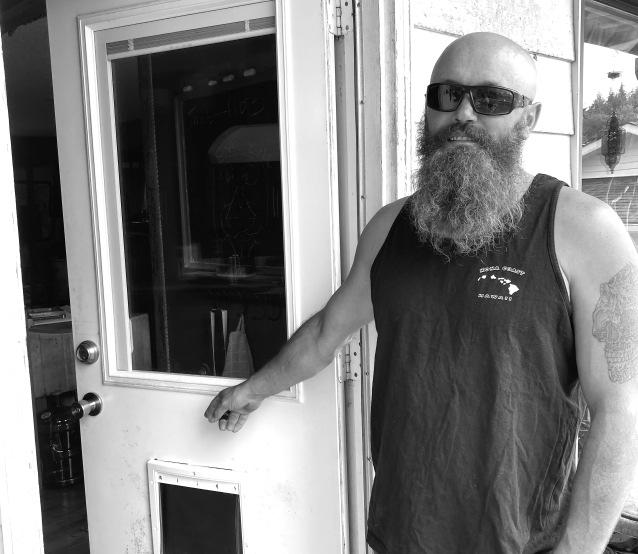
Submitted photo
Ucluelet homeowner Brandon Halvorson stands beside the dog door a bear used to enter his house around July 17 or 18.
According to a report prepared by Bob Hansen at WildSafeBC, “the nature and trend of the documented human-bear conflicts on the west coast has changed since the implementation of the residential cart system in the Fall of 2022.”
Hansen reports that in 2023, conflict bears noticeably shifted away from common attractants and started to primarily focus on garbage, organics and recycling carts.
“This behaviour progressed and the number of food-conditioned bears increased throughout the year 2023,” Hansen wrote.
Flash-forward to the summer of 2025, and the number of cart conflicts continues to climb with reports of food-conditioned bears learning to break brass clips, tearing apart lids and a sow teaching her cubs how to break into the carts, “illustrating

the last week of July for failing to secure waste. The written warning gives the residents two weeks to fix the situation or face a fine up to $300 under the bylaw.
“Furthermore, if your situation results in attracting a bear onto your property, then whether or not the bear is killed, you may receive additional penalties under the provincial WildlifeAct,” reads a portion of the warning letter from theAlberniClayoquot Regional District’s (ACRD) solid waste manager Paulo Eichelberger.
TheACRD provides bi-weekly garbage and recycling pick-up to residents in Tofino, Ucluelet, and surrounding Nuu-chah-nulth communities. Organics are collected weekly.Amessage to waste manager Eichelberger was not returned.
WildSafeBC Pacific Rim community co-ordinator Chris Read meets regularly with Ucluelet bylaw and theACRD to help mitigate wildlife attractants and secure bins in town.
the process of generational learning”, Hansen reports.
Ucluelet mayor and council discussed the human-bear conflict during the July 22 regular meeting after receiving a letter from resident Robyn Mair that suggested Ucluelet move away from curbside pickup to a centralized, communal waste drop-off location like other resort communities such as Whistler and Banff.
Councillor Mark Maftei called centralizing garbage a “red herring” and that the main problem is “people ignoring the rules.”
Maftei, who is the executive director of the Raincoast Education Society (RES), put forward the idea of composting less during the summer months to reduce bear conflict and fining “repeat offenders” into compliance.
“I could list 45 culprits. There needs to be fines. Start issuing fines,” re-iterated Councillor Mayco Noel.
“We need 100 per cent compliance,” said Councillor Jennifer Hoar, who reported that a bear “nosed into the tea shop” in the middle of the day.
Ucluelet bylaw officer Brittney Willms issued 21 warning notices to residents in
Ideally, Read said the carts need to be kept inside until garbage pick-up or anchored down. Replacing brass carabiners with steel carabiners has also been effective, according to WildSafeBC, and freezing organics before collection day helps reduce the smell.
“Bears are smart. Bears are strong. Once they associate one bin having food and having a good reward, now they know the skill and they can use that and go down the street,” said Read.
“I know it’s not the best system, but it’s what we have right now. We’re just trying to use what funding we have to make it better to see if we can reduce the learning of new bears into our community,” he said. “As we know, they get killed, they get conditioned, there is a long pathway that leads them to that.”
Crosswalks and storefronts along Ucluelet’s Peninsula Road were recently vandalized with red bears with wings. It’s uncertain as to why the “angel bears” appeared, but many locals think they serve as a public reminder to be diligent with garbage… or more bears will end up dead.
Anyone that needs help securing bins or replacing carabiners is encouraged to email Chris Read at: pacrim@wildsafebc. com.
Report all wildlife conflicts to the COS RAPP line at 1-877-952-7277.

Hello Everyone. Hoping you all are enjoying this beautiful summer and getting in lots of food fish, berries, medicines, cedar and grasses. It is a busy time of the year. Again, condolences go out to the losses in your communities and sending sympathies to families, friends and communities.
July has gone quickly. We did a two-day summit with representatives from each nation setting out strategies to tackle the toxic drug and mental health crisis. A 3-60-90-day plan was put in place. We know our plan can succeed because we know our people, will use cultural integration, have youth-elder partnership, have real-time responsiveness and have a holistic ecosystem looking at root causes and our evaluation excellence. We looked at six themes and set our strategies that includes leadership, youth, harm reduction, collaboration and funding and community engagement and holistic support.
I attended a preparatory meeting for the chiefs to meet Prime Minister Carney in Ottawa. No one is happy with his new law that allows his government to push through development projects without First Nations’consent. Developments could destroy or impair our ability to carry out our rights due to destruction of ecosystems and other environmental issues. The government can push through any project they deem to be of national interest. They do not in any way involve First Nations in defining what is national interests. This law does not live up to the honour of the Crown nor are they looking at the duty to consult with the intent of obtaining the free, prior and informed consent. While the prime minister did listen to the chiefs, he has not made any commitments to change the legislation, though he says he will respect our rights. This is not in the law, and we have never been able to trust the government by their word and I know this will not be any different. Chiefs in Ontario are bringing a lawsuit challenging this law and the one passed by Ontario in order for the government to uphold rights and title and s. 35 and United Nations Declaration on the Rights of Indigenous People and United Nations Declaration on the Rights of Indigenous PeoplesAct (Canada) . I attended the Leadership Council meeting on toxic drug and mental health crisis. This meeting turned out to be a series of panels talking about impacts in the community, provincial efforts and programs in communities. In the end, there was not any recorded plan or recommendations but agreement to hold another forum. There was good information on what First Nations/organizations were doing but as the panels took time there wasn’t time to do discussion after each panel. Heath Minister Osborne just talked about all the health centres the province had provided and her visits to some of the communities. Not much substance. Everyone recognizes the urgency/ crisis of this situation but no one with resources to assist.
Many of you know that getting births registered with Indigenous Services Canada can take a long time. Two years and more. TheAuditor General says on average it is 16 months. This means that our young children are not considered status Indians with their rights that go with it. It also means that when funding for a First Nation is calculated, our children are not counted, which means less money for your first Nation. This has been an ongoing problem and the

executive has met with the regional director general and the minister of Indigenous Services Canada about this, with no resolve. Now theAuditor General has done a report that says that there is a backlog of over 12,000 applications. TheAuditor General told ISC to find better ways to do applications and to put in place a plan to do away with the backlog. TheAuditor General also recommended that proper funding be given to First Nations for their membership clerks so they can do their job. NTC does do membership for some of the nations, but many do the applications themselves.
Premier David Eby did a small cabinet shuffle. Christine Boyle who was newly appointed as Indigenous Relations and Reconciliation minister following the B.C. election was moved out to housing. The new minister is Spencer ChandraHerbert. It is unknown how he will be as MIRR. Relations will now have to be re-established with a new minister. In making the cabinet shuffle, the premier says his cabinet will work on the province’s biggest challenges that is growing the economy, seizing investment opportunities and strengthening public services. Nothing about First Nations as a priority. I have continued work on amending the heritage legislation to be consistent with UNDRIP. There will be engagements with First Nations on the framework for legislation known as the request for decisions. First Nations should be aware of this engagement and analyze the six policy areas and ensure they meet your needs.
The Tlu-piich games are being held August 11-14th with opening ceremonies on the 11th at 5:30 p.m. at Bob Dailey Stadium. Hope you bring your teams out and have fun. The games have always been fun and a good gathering for Nuuchah-nulth.
It is great to see all the events happening in our communities, including canoe journeys, House of Huu-ay-aht 25th anniversary celebration, the grand opening of the Somass Hall, Toquaht welcoming their children home, and Uchucklesaht doing a pole raising and many First Nations doing their cultural camps and gatherings out in their territories. Wishing everyone the best as they celebrate so many things in their communities and look forward to attending some of them.
Look forward to reporting to you next month.
Respectfully,
Cloy-e-iis, Judith Sayers

ActiveAll Stars
Wednesdays from July 16th –August 27th
4841 Redford Street – The Nucii Gymnasium
Every Wednesday 2:00pm – 4:00pm Drop In and join theActiveAll Stars!A fun and supportive gym program for kids aged 5+. TheActiveAll Stars supports a growth mindset, building gross motor skills, team work and positivity. For more information contact Desiree at desiree. sanderson@nuuchahnulth.org or 250724-3939 ext. 5282


President’s Message &Community Beyond

NCN Mental Health Counselling Tuesdays and Thursdays 8:30am – 4:30pm
4841 Redford Street, PortAlberni
NCN Mental Health Services – DropIn Counselling with Margaret Bird, Registered Clinical Counsellor and Play Therapist. For on and off reserve members of all ages of the Nuu-chahnulth Tribal Council. Call (250) 724-3939 to book your appointment.
In memory

Mobile Hair Stylist
27 years as a licensed hair stylist. Able to go to elders/handicapped homes to cut, perm or color hair. Would also do in own home.
25 Years Ago in
Ha-Shilth-Sa
Vol. 27 – No. 16 August 10, 2000
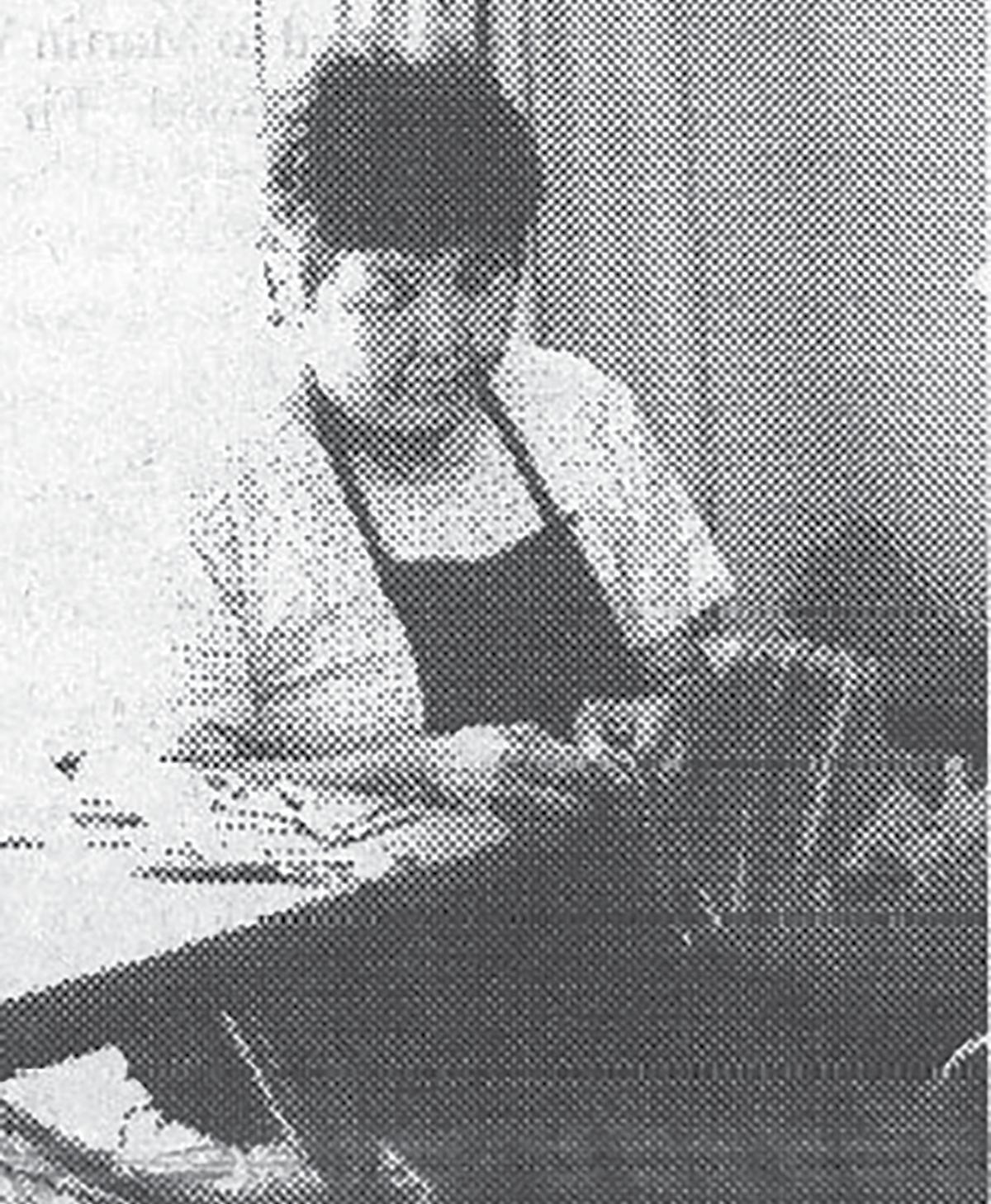
Julia Lucas working on one of her many cedar pieces. space where women gathered, laughed, shared culture, and gained a sense of community. Often, they would work until the early hours of morning creating their capes and baskets. The ladies’ quick fingers and skill made it look deceptively simple, but it was their patience and eagerness to teach that was prized among the beginners of the group.
The traditions and love of weaving cedar bark were being passed on in a cozy apartment in PortAlberni. Mae Titian welcomed others into her home with the aromas of hot coffee and the sweet distinctive smell of the inner bark soaking. Julia Lucas took on the role of teacher, trainer and supporter as her mentors had done for her. Through sharing knowledge, they created a
In memory of Ricky J. Masso who passed awayAugust 8, 1993. We miss you, dear brother.












Huu-ay-aht First Nations traditional territory was serenaded July 18-20 as about 60 artists performed across three stages for over 900 people during the fourth Pachena Bay Music Festival.
Pachena Bay Music Festival opens synergies
Festival co-founder Ben Howells says longform gatherings in beautiful places are quintessential for humanity
By Nora O’Malley Local Journalism Initiative Reporter
Anacla, BC – There’s a lull on Saturday morning and Ben Howells finds himself with time to be loquacious.
He’s relaxed after the game of “human Tetris” his crew played to negotiate over 700 festivalgoers plus roughly 150 volunteers into Huu-ay-aht’s Pachena Bay Campground was completed early Friday evening.
Moreover, he shared that whales swam into the bay on Thursday afternoon during his own DJ performance, which stirred a feeling of significance.
“If going to the abandoned warehouses in Chicago or the shipyards in New York is synonymous with early rave culture, part of our culture is bringing music out into beautiful places,” said Howells, who co-founded the Pachena Bay Music Festival with his wife Katreena Bennett, mentorAvigdor (Vig) Schulman and Dallas Stevenson.
“I believe that events where groups of people of multiple ages and ideas, and people who are different, come together for a longform gathering, three or four days, that those gatherings are quintessential for the development of the human race over time,” Howells continued.
“Longform gatherings such as these result in certain positive synergies that have helped humanity along, like the sharing of ideas, the sharing of genetics, the sharing of germs…and all those things mixed together make humans stronger,” he said.
Just coming off a successful fourth showing, Pachena Bay Music Festival took over Huu-ay-aht First Nations (HFN) shorefront July 18, 19 and 20. HFN members delivered the welcome speech, which established the overall vibe of the event: safe and happy, flowing with the nation’s sacred principles of respect (ʔiisaak), taking care of (ʔuuʔałuk) and everything is one (hišuk ma cawak).
“Alot of people just want the opportunity to do the right thing,” said Howells.
Olivia Peters, who comes from a long line of Huu-ay-aht Tyee Ha’wiih, welcomed guests to her territory after Friday’s opening parade. Peters, whose Indigenous name translates to ‘daughter of the moon’, shared with the crowd that a long, long time ago, Pachena Bay was given to her great grandmotherAggie Peters as a wedding dowry.
“My direct family has been the caretakers of this beach for many generations,

and now the responsibility is now passed on to the women in the Peters family, such as myself, a couple of my grandmothers and my auntie,” said Peters.
Qiic Qiica, a cultural interpreter for Kiixin Tours (HFN’s ancient village site) and speaker for the nation, spoke about resilience. He said his ancestors had to “fight and die for the land they live on” and endured tsunamis, famine, colonization and disease.
“Despite being displaced by all the government policies and the churches and their effort to take away our language and culture we are still here,” said Qiic Qiica.
The crowd cheered.
He went on to tell the audience that the music festival is a form of reconciliation and a step in the right direction.
“The great festival organizers went out of their way to make sure that we could be there to do the traditional welcome into our territory,” he said.
Drum in hand, Huu-ay-aht Councillor Edward Johnson sang a canoe song, composed by Qiic Qiica, about working together as one.Abig circle was formed and folks danced to the song, doing paddle strokes in unison.
“I’m just impressed with Huu-ay-aht,” said Howells. “I see the vision in terms of economic strategies.Alot of that stuff I really see it and I see the strength. I see the strength growing.”
Howells spent 13 years planting millions of trees in TFL (Tree Farm Licence) 44. He’s seen the TFL transition from Western Forest Products to Tsawak-qin
Forestry and managed crews that helped reforest the cutblocks along the Bamfield Main.
“That’s a whole other interview, but for me, as a rule of thumb, I imagine that the land in the hands of people who drink the water and live in the land is naturally going to result in better stewardship,” he said.
When he originally proposed the concept of a music festival at Pachena Bay to former Huu-ay-aht chief councillor Robert Dennis Sr., Howells says his approach came from the perspective of growing up in the small community of Cortes Island.
“People need to be talked to face to face and need to do things at their own pace. That is sort of something that guides me,” said Howells, who married Katreena on Brady’s Beach near Bamfield.
“We were all feeling the love. That’s the strongest seed that truly grew,” he told the Ha-Shilth-Sa.
Howells said another unique “under thread” of the Pachena Bay Music Festival is the absence of garbage bins around the campsite. Festivalgoers need to pack out whatever they pack in.
“It’s one of those things; we get very disconnected with our garbage. I’m not saying you’re bad if you didn’t recycle that thing, whatever it was, that piece of garbage is with you for longer. You just have to hold it for longer,” said Howells.
Black bear concerns
On July 18, the day most of the festival folk arrived, Huu-ay-aht posted a bul-
letin about an active black bear wandering around the village ofAnacla, which neighbours the Pachena Bay Campground, seeking out garbage and unsecured food.At one point during the threeday festival the bear wandered into the campground and was chased up a tree.
Authorities scared it off into the forest, but it was seen skirting around the area, munching on dandelions. The nation says it’s hoping to humanely trap it for relocation within its home range.
Howells shared that the reason why a lot of festivals don’t take place in wild and beautiful locations like Pachena Bay is because they are too risky from a business perspective.
“That’s why you see so many concerts at exhibition grounds and boring locations,” he said. “I deal with the innocent ignorance, the lack of knowledge, with communication kindly communicated. But of course, if that ignorance persists, it’s no longer ignorance anymore, it’s now just being a (big) asshole and it’s time to go,” said Howells.
“We don’t want to eff this up.As soon as you step foot down here, it becomes apparent to people,” he said.
Huu-ay-aht receives more revenue during the festival than if their campground was fully booked and the town of Bamfield gets a boost too, but Howells respectively acknowledges that if, at any given time, Huu-ay-aht’s chief, council and the residents of upper and lowerAnacla want the festival to go, it could just be done.
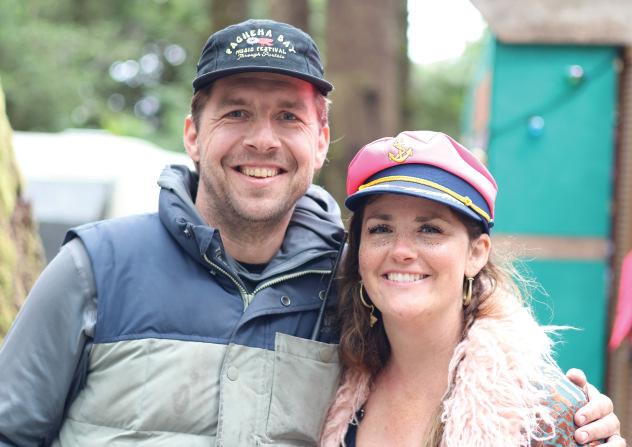
Nora O’Malley photos
Pachena Bay Music co-founders Ben Howells and Katreena Bennett were married on Brady’s Beach near Bamfield, planting the strongest seed for the special festival.
Olivia Peters
